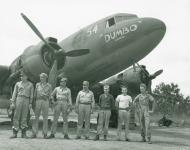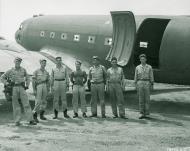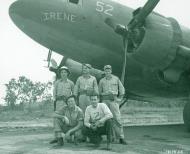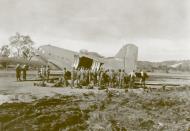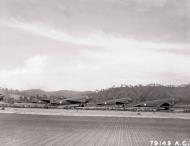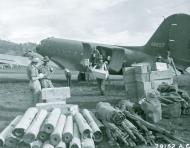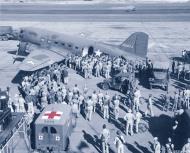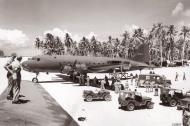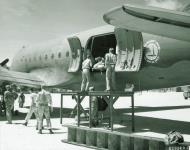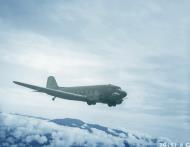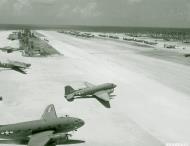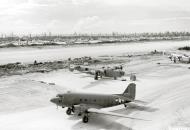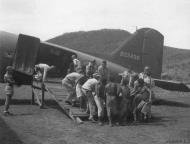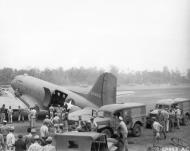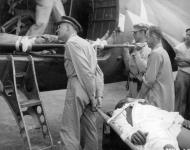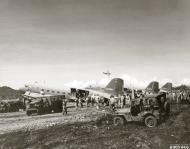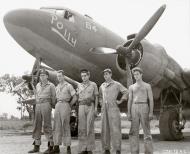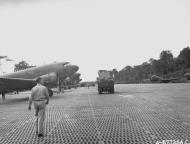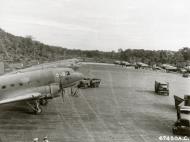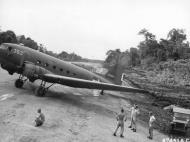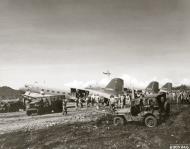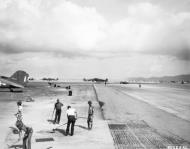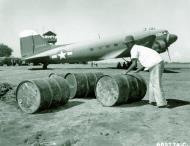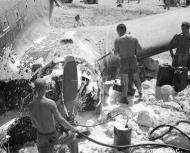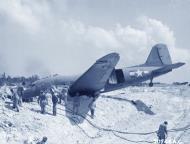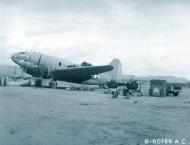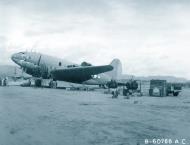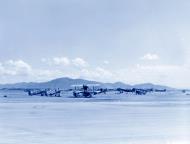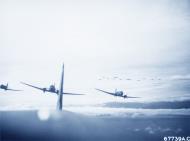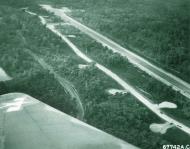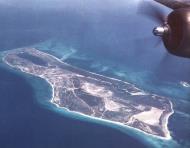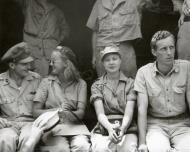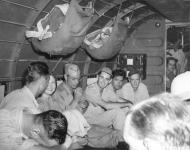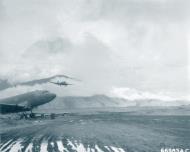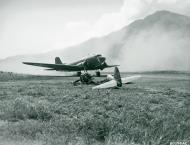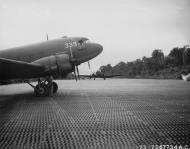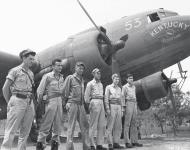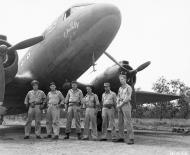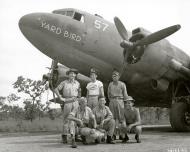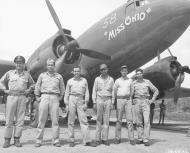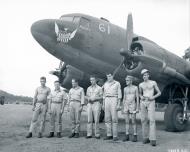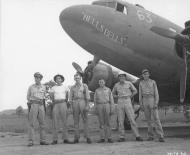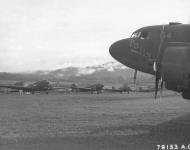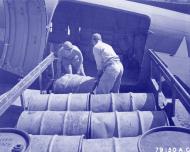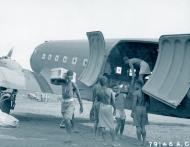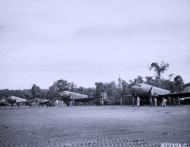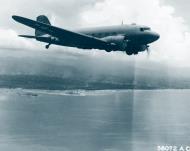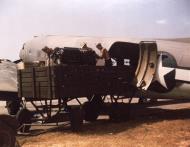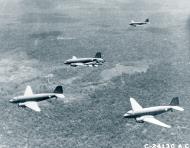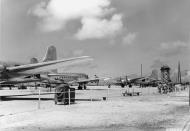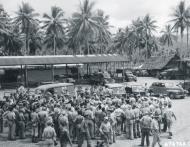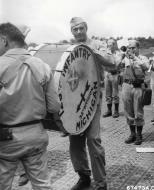USAAF Transport Aircraft used in the PTO photo gallery
Aerial view of Caicos Island or Turks and Caicos Islands Atlantic Ocean and N.West Indies 1946 NA096
Photo description: Aerial Of Island In The Saices Bank, In The Atlantic Ocean. (U.S. Air Force Number K4482) The Turks and Caicos Islands are a British Overseas Territory consisting of the larger Caicos Islands and smaller Turks Islands, two groups of tropical islands in the Lucayan Archipelago of the Atlantic Ocean and northern West Indies. They are known primarily for tourism and as an offshore financial centre
Photo Source: National Archives Identifier NAID: 205001491 Local ID: 342-FH-3A49302-K4482
Aerial view of the airstrip on Wakde Island New Guinea NA513
Photo description: Aerial view of airstrip on Wakde Island, New Guinea. (U.S. Air Force Number 79141AC)
Photo Source: National Archives Identifier NAID: 204954785 Local ID: 342-FH-3A32179-79141AC
Aerial view of 7 Mile Strip At Fort Moresby Papua New Guinea 1943 NA1270
Photo description: Aerial View Of 7 Mile Strip At Fort Moresby, Papua, New Guinea Showing Revetments For B-17 "Flying Fortress" Planes On The Dispersal Area. April 1943. (U.S. Air Force Number 79144AC)
Photo Source: National Archives Identifier NAID: 204955997 Local ID: 342-FH-3A32621-79144AC
Douglas C-47 Skytrain or Dakota and Douglas C-53 Skytrooper photo gallery
44-78481 Curtiss C-46 Commando Quivering Sal at Clark Field Luzon Philippines 25th Jun 1945 NA529
Photo description: Mechanics Changing Engine On Curtiss C-46 Commando 'Quivering Sal' At Clark Field, Luzon, Philippine Islands - 25 June 1945. (U.S. Air Force Number B60766AC)
Photo Source: National Archives Identifier NAID 204951873 Local ID: 342-FH-3A30689-B60766AC
42-93484 Douglas C-47 Skytrain at Laoag Field Luzon Philippines 20th May 1945 NA529
44-78481 Curtiss C-46 Commando Quivering Sal at Clark Field Luzon Philippines 25th Jun 1945 NA529
Photo description: A native laborer moves fuel drums which have been unloaded from a Douglas C-47 of the 318th Troop Carrier Commandos at Laoag Air Strip on Luzon, Philippine Islands. 20 May 1945. (U.S. Air Force Number 68977AC)
Photo Source: National Archives Identifier NAID 204951286 Local ID: 342-FH-3A30991-68977AC
Douglas C-47 Dakota after leaving Torokina Strip on Bougainville Solomons 1944 NA137
Photo description: (U.S. Air Force Number 56072AC)
Photo Source: National Archives Identifier NAID: 204985371 Local ID: 342-FH-3A43503-56072AC
Douglas C-47 Dakota RNZAF Torokina Strip on Bougainville Solomons 29th Mar 1944 NA1080
Photo description: Unloading a New Zealand C-47 plane at the Torokina Airstrip, Bougainville. 29 March 1944. (U.S. Air Force Number 80084AC)
Photo Source: National Archives Identifier NAID: 204986911 Local ID: 342-FH-3A44064-80084AC
Douglas C-47 Dakota being loaded at a freight terminal in Panama NA200
Photo description: Unloading Douglas C-47 Being Loaded At Freight Terminal In Panama. (U.S. Air Force Number K1937)
Photo Source: National Archives Identifier NAID: 205001647 Local ID: 342-FH-3A49354-K1937
Aircrew 20th Troop Carrier Squadron barracks in the Panama
Photo description: 20Th Troop Carrier Crew Leaves Barracks For Morning Mission. Panama. (U.S. Air Force Number K1994)
Photo Source: National Archives Identifier NAID: 205001539 Local ID: 342-FH-3A49318-K1994
4th Air Depot based at Garbutt Field Townsville was a major repair center in Australia 13th Dec 1943 NA600
42-92796 C-47A Dakota RAAF VH-CJI at Garbutt Field Townsville Australia 13th Dec 1943 NA600
Photo description: NA604 Hard standing No. 4 taken from edge of 67 degree runway, Garbutt Field, Townsville, Australia. 13 December 1943. (U.S. Air Force Number B80122AC); Hard standing adjacent to 130 degree runway near main repair depot at Garbutt Field, Townsville, Australia. 13 December 1943. (U.S. Air Force Number 80122AC)
Photo Source: National Archives Identifier NA604 NAID: 204948741 Local ID: 342-FH-3A29898-B80122AC
Photo Source: National Archives Identifier NA600 NAID: 204948735 Local ID: 342-FH-3A29896-80122AC42-23860 Douglas C-47 Dakota 328 Sure Skin with 329 at Finschhafen New Guinea 13th Dec 1944 NA548
Douglas C-47 Dakota 361 with 363 at Finschhafen New Guinea 13th Dec 1944 NA544
Douglas C-47 Dakota 339 with 374TCG6TCS 28 Eve Finschhafen New Guinea 18th Dec 1944 NA565
Photo description: Unloading Supplies For A Fighter Group From Douglas C-47's At Finchhafen, N.E. New Guinea, 18 December 1943. Note Nickname 'Sure Skin' On C-47 In The Foreground. (U.S. Air Force Number 67736AC); (U.S. Air Force Number 67735AC); (U.S. Air Force Number 67734AC)
Photo Source: National Archives Identifier NAID: 204957719 Local ID: 342-FH-3A32986-67736AC
Photo Source: National Archives Identifier NAID: 204956719 Local ID: 342-FH-3A32984-67735AC
Photo Source: National Archives Identifier NAID: 204954846 Local ID: 342-FH-3A32213-67734ACDouglas C-47 Dakota 374TCG6TCS 28 Eve at Finschhafen New Guinea 13th Dec 1944 NA989
Photo description: Crew members of a Douglas C-47 pose beside their plane at Finschhafen, N.E. New Guinea after landing with supplies for a fighter group. 18 December 1943. (U.S. Air Force Number 67732AC)
Photo Source: National Archives Identifier NAID: 204955464 Local ID: 342-FH-3A32465-67732AC
42-24218 Douglas C-47A Dakota 374TCG6TCS unloading at Finschhafen New Guinea 18th Dec 1944 NA542
Photo description: Supplies for a fighter group are unloaded from a Douglas C-47 at Finschhafen, N.E. New Guinea, 18 December 1943. (U.S. Air Force Number 67733AC)
Photo Source: National Archives Identifier NAID: 204956716 Local ID: 342-FH-3A32983-67733AC
42-23860 Douglas C-47 Dakota 328 Sure Skin with 329 at Finschhafen New Guinea 13th Dec 1944 NA546
Photo description: Wewak Airdrome, Northeast... (U.S. Air Force Number A67735AC)
Photo Source: National Archives Identifier NAID: 204956722 Local ID: 342-FH-3A32985-A67735AC
Douglas C-47 Dakota 339 with 332 Finschhafen New Guinea 13th Dec 1944 NA550
Photo description: Transports are unloaded at Finschhafen, N.E. New Guinea. Note the fighter plane parked between the Douglas C-47's. 18 December 1943. (U.S. Air Force Number 67737AC)
Photo Source: National Archives Identifier NAID: 204956725 Local ID: 342-FH-3A32987-67737AC
42-23860 Douglas C-47A Dakota 328 Sure Skin over Finschhafen New Guinea 19th Jan 1944 NA601
Photo description: Douglas C-47 "Sure Skin" enroute to Finschhafen, N.E. New Guinea, carrying supplies for a fighter group. 18 December 1943. (U.S. Air Force Number 67738AC)
Photo Source: National Archives Identifier NAID: 204954881 Local ID: 342-FH-3A32234-67738AC
Douglas C-47A Dakota's over Finschhafen New Guinea 19th Jan 1944 NA534
Douglas C-47A Dakota's over Finschhafen New Guinea 19th Jan 1944 NA536
Photo description: Douglas C-47's enroute to Finschhafen, N.E. New Guinea, carrying supplies for a fighter group. 18 December 1943. (U.S. Air Force Number 67739AC); (U.S. Air Force Number 67740AC)
Photo Source: National Archives Identifier NAID: 204954821 Local ID: 342-FH-3A32193-67739AC
Photo Source: National Archives Identifier NAID: 204954824 Local ID: 342-FH-3A32194-67740ACDouglas C-47A Dakota's approaching to land at Finschhafen New Guinea 18th Dec 1944 NA507
Douglas C-47A Dakota turning base to land at Finschhafen New Guinea 18th Dec 1944 NA507
Photo description: Runway And Revetments Of Air Base Of The 5Th Army Air Force At Finchhafen, N.E. New Guinea, 18 December 1943. Filed: War Theatre #19 (Finchhafen, N.E. New Guinea) Aerials (U.S. Air Force Number 67741AC); (U.S. Air Force Number 67742AC)
Photo Source: National Archives Identifier NAID: 204955856 Local ID: 342-FH-3A32176-67741AC
Photo Source: National Archives Identifier NAID: 204954782 Local ID: 342-FH-3A32177-67742AC42-23615 Douglas C-47A 5AF 221 Dakota Medvac flight Hollandia New Guinea 20th Apr 1943 NA260
42-23615 Douglas C-47A 5AF 221 Dakota Medvac flight Hollandia New Guinea 20th Apr 1943 NA270
Photo description: Ambulances from the 36th Evacuation Hospital at Hollandia bring litter and walking cases to Douglas C-47's to be evacuated by air to Lae and Nadzab, New Guinea. (U.S. Air Force Number 52993AC); (U.S. Air Force Number 52994AC)
Photo Source: National Archives Identifier NAID: 204956287 Local ID: 342-FH-3A32768-52993AC
Photo Source: National Archives Identifier NAID: 204956302 Local ID: 342-FH-3A32773-52994ACDouglas C-47 Dakota 5AF 374TCG6TCS unloading supplies at Wau New Guinea Apr 1943 NA567
Photo description: Natives unload C-47 transport of the 6th Troop Carrier Squadron at Wau, New Guinea where the supplies are ferried from Port Moresby, New Guinea. April 1943. (U.S. Air Force Number 79146AC)
Photo Source: National Archives Identifier NAID: 204956753 Local ID: 342-FH-3A32995-79146AC
Cargo glider being loaded with frieght at Archerfield Brisbane Australia May 1943 NA519
Photo description: The nose of a cargo glider is opened prior to loading with freight. The work is done by the directorate of Air Transport members. Archerfield, Brisbane, Australia. May 1943. (U.S. Air Force Number 79147AC)
Photo Source: National Archives Identifier NAID: 204948646 Local ID: 342-FH-3A29852-79147AC
41-18660 Douglas C-47 Dakota 5AF 374TCG6TCS 79 Shanghai Lil in Port Morseby New Guinea 7th Jan 1944 NA569
41-38665 Douglas C-47 Dakota 5AF 374TCG6TCS 86 at Ward's Drome Port Morseby New Guinea 7th Jan 1944 NA569
Photo description: C-47 Transport Planes, Of 6Th Troop Carrier Squadron, Lined Up Ready To Taxi Down Strip For Take-Off, Carrying Supplies To Forward Combat Area, Ward's Drome, Port Moresby, New Guinea. April 1943. (U.S. Air Force Number 79149AC)
Photo Source: National Archives Identifier NAID: 204955891 Local ID: 342-FH-3A32215-79149AC
Douglas C-47 Dakota 5AF 374TCG6TCS being loaded at Ward's Drome Port Moresby New Guinea Apr 1943 NA569
Photo description: Members of 8th Service Squadron load C-47 transport of 6th Troop Carrier Sq., 5th Air Force, with drums of gasoline for forward combat area,Ward's Drome, Port Moresby, New Guinea. April 1943. (U.S. Air Force Number 79150AC)
Photo Source: National Archives Identifier NAID: 204956756 Local ID: 342-FH-3A32996-79150AC
41-38678 Douglas C-47 Dakota 374TCG6TCS 62 Swamp Rat II escorted by 35FG41FS over New Guinea 7th Jan 1944 NA521
41-38678 Douglas C-47 Dakota 374TCG6TCS 62 Swamp Rat II escorted by 35FG41FS over New Guinea 7th Jan 1944 NA605
Photo description: NA605 C-47 transport of 6th Troop Carrier Squadron on mission carrying supplies to Wau, New Guinea, from Ward's Drome, New Guinea. April 1943. (U.S. Air Force Number 79151AC); NA521 (U.S. Air Force Number 79154AC)
Photo Source: National Archives Identifier NA605 NAID: 204954887 Local ID: 342-FH-3A32236-79151AC
Photo Source: National Archives Identifier NA521 NAID: 204954798 Local ID: 342-FH-3A32185-79154AC41-18697 Douglas C-47 Dakota 5AF 374TCG6TCS 57 unloading supplies at Wau Papua New Guinea Apr 1943 NA571
Photo description: Australian Soliders Unload C-47 Transport Of The 6Th Troop Carrier Squadron At Wau Whence It Came From Port Moresby, Ward'S Drome, New Guinea. April 1943. (U.S. Air Force Number 79152AC)
Photo Source: National Archives Identifier NAID: 204957722 Local ID: 342-FH-3A32997-79152ACC
Douglas C-47 Dakota 5AF 374TCG6TCS 64 Polly in Wau New Guinea Apr 1943 NA573
Photo description: C-47 transport planes of the 6th Troop Carrier Squadron lined up on Wau, New Guinea, landing strip during unloading operations. Planes are based at Ward's Drome, Port Moresby, New Guinea. April 1943. (U.S. Air Force Number 79153AC)
Photo Source: National Archives Identifier NAID: 204956759 Local ID: 342-FH-3A32998-79153AC
Douglas C-47 Dakota 5AF 374TCG6TCS 64 Polly in Wau New Guinea Apr 1943 NA573
Photo description: C-47 transport planes of the 6th Troop Carrier Squadron lined up on Wau, New Guinea, landing strip during unloading operations. Planes are based at Ward's Drome, Port Moresby, New Guinea. April 1943. (U.S. Air Force Number 79153AC)
Photo Source: National Archives Identifier NAID: 204956759 Local ID: 342-FH-3A32998-79153AC
43-15416 Douglas C-47A Skytrain 375TCG54TCS Lt JF Dailey overshot rwy at Angaur Isl Caroline Isls 23rd Oct 1944 NA422
43-15416 Douglas C-47A Skytrain 375TCG54TCS Lt JF Dailey overshot rwy at Angaur Isl Caroline Isls 23rd Oct 1944 NA424
43-15416 Douglas C-47A Skytrain 375TCG54TCS Lt JF Dailey overshot rwy at Angaur Isl Caroline Isls 23rd Oct 1944 NA426
Photo description: NA426 A Douglas C-47 of ths 54th Troop Carrier piloted by Lt. J.F. Dailey, crashed when it overshot the runway on Angaur Island, Caroline Islands, 23 October 1944. Both landing gears were torn away, the right engine nacelle was torn from the wing, the other engine smashed beyond salvage and the fuselage was wrinkled. (U.S. Air Force Number 70746AC); NA424 (U.S. Air Force Number 70745AC); NA422 (U.S. Air Force Number 70744AC)
Photo Source: National Archives Identifier NA422 NAID: 204970738 Local ID: 342-FH-3A38265-70744AC
Photo Source: National Archives Identifier NA424 NAID: 204970741 Local ID: 342-FH-3A38266-70745AC
Photo Source: National Archives Identifier NA426 NAID: 204970786 Local ID: 342-FH-3A38267-70746AC41-18649 Douglas C-47 Dakota 5AF 374TCG6TCS loading supplies in Australia 12th Jan 1942 NA512a
Photo description: American troops unloading Aussie and Jap rifles from a C-47 (U.S. Air Force Number 23686AC)
Photo Source: National Archives Identifier NAID: 204956663 Local ID: 342-FH-3A32962-23686AC
41-18648 Douglas C- 47 Dakota 5AF 374TCG in Papua New Guinea 1943 NA506
Photo description: Australian troops unload a transport at an airbase somewhere in New Guinea. (U.S. Air Force Number 23385AC)
Photo Source: National Archives Identifier NAID: 204956653 Local ID: 342-FH-3A32958-23385AC
Douglas C-47 Dakota 5AF 374TCG6TCS 56 Dear Mom at Wards Drome Port Morseby New Guinea Apr 1943 NA1056
Photo description: C-47 transport plane, "Dear Mom" and its crew from the 6th Troop Carrier Sq. 5th Air Force, Wards Drome, Port Moresby, New Guinea. Left to right, 2nd Lt. George W. Beaver, Warren, Ohio, pilot; 2nd Lt. Hubert S. Bronson, Hastings, Mich, co-pilot; S/Sgt. Kenneth G. Wagoner, Barnes, Kansas, aerial engineer; Cpl. Lawrence Billmaier, Ida, Mich., radio operator; Cpl. Ferdinand Milisci, Allston, Mass., engr; Pvt. Robert Fraser, Pittsburg, Pa., engr; and Pvt. John Ballantine, Worchester, Mass., radio operator. April 1943. (U.S. Air Force Number 79164AC)
Photo Source: National Archives Identifier NAID: 204955540 Local ID: 342-FH-3A32500-79164AC
Douglas C-47 Dakota 5AF 374TCG6TCS 57 Yard Bird at Wards Drome Port Morseby New Guinea Apr 1943 NA1058
Photo description: The C-47 trpipsort plane, "Yard Bird" and its crew from 6th Troop Carrier Sq. 5th Air Force, Wards Drome, Port I Moresby, New Guinea. Left to right are; Cpl. Gerald Bogacki, Detroit, Mich., radio operator; Cpl. Robert Kerr, Fayetteville, Ark., radio operator; Pfc Sidney Kopelson, Akron, Ohio ass't engr; second row; Lt. Frank C. Libuse, Chicago, 111. pilot; Lt. David C. Vaughter, Amherst Texas; co-pilot and Cpl. Herbert Smith, Tfthoka, Texas, engr. April 1943. (U.S. Air Force Number 79165AC)
Photo Source: National Archives Identifier NAID: 204955543 Local ID: 342-FH-3A32501-79165AC
41-18568 Douglas C-47 Dakota 5AF 374TCG6TCS 54 Dumbo at Wards Drome Morseby New Guinea Apr 1943 NA1060
Photo description: The C-47 Transport plane "Dumbo" and its crew of the 6th Troop Carrier Squadron, 5th Air Force, Wards Drome, Port Moresby, New Guinea. Left to right: Capt. William A. Peterson, Freeport, Ill. pilot; 2nd Lt. John R. Meeks, Cordele, Ga., co-pilot; T/Sgt. Paul Shirenan, Camp Douglas, Wise, engr; Sgt. Ernest Wooten Jr., Norfolk, Va., crew chief; Pfc Erwin M. Richers, St. Paul, Minn., ass't engr; Sgt. Curtis T. Mills, W. Winfield Pa., radio operator and Pfc Raymond W. Marlinson, Berchwood, Wise., assistant radio operator. April 1943.(U.S. Air Force Number 79166AC)
Photo Source: National Archives Identifier NAID: 204955546 Local ID: 342-FH-3A32502-79166AC
41-38678 Douglas C-47 Dakota 5AF 374TCG6TCS 62 Swamp Rat II in Port Morseby New Guinea Apr 1943 NA1064
Photo description: C-47 transport plane "Swamp Rat" and its crew from 6th Troop Carrier Sq. 5th Air Force, Wards Drome, Port Moresby, New Guinea. Left to right, 2nd Lt. Irwin W. Dial, Mendota, Ill., pilotnd Lt. Robert S. Knight, Omaha, Neb., co-pilot; S/Sgt. Gilman Gilbertson, Wilmar, Minn.,engnr Pvt. Cyril Arnzen, St. Cloud, Minn, radio operator; Sgt. Claude Scouten, Williamsport, Pa., Engr; Pfc Lester Barryman, Chicago, Ill., radio operator; and Pvt. Sydney Mooney, Los Angeles Calif., Engr. April 1943. (U.S. Air Force Number 79167AC)
Photo Source: National Archives Identifier NAID: 204955552 Local ID: 342-FH-3A32504-79167AC
Douglas C-47 Dakota 5AF 374TCG6TCS 58 Miss Ohio at Wards Drome Port Morseby New Guinea Apr 1943 NA1062
Photo description: C-A7 transport plane "Mss Ohio" and its crevi from 6th Troop Carrier Sq., 5th Air Force,Wards Drome, Port Moresby, New Guinea. Left to right: Lt. Blesch Malrastone, Wayland, Mich., pilot; Smith, Hutchison, Kansas, co-pilot; S/Sgt. Robert R. Kerr, Waynesburg, Pa., engr; Clayton, Watertown, S.I., engr; Cpl. Joseph T. Perez, Canton, Ohio, radio operator Lt. Isaac W. Sgt. Clay D. and Cpl. John A. Crane, Phoenix, Ariz., radio operator. April 1943. (U.S. Air Force Number 79168AC)
Photo Source: National Archives Identifier NAID: 204955549 Local ID: 342-FH-3A32503-79168AC
Douglas C-47 Dakota 5AF 374TCG6TCS 61 at Wards Drome Port Morseby New Guinea Apr 1943 NA1066
Photo description: C-47 transport plane and its crew from 6th Troop Carrier Sq. 5th Air Force, Wards Drome, Port Moresby, New Guinea, Pvt. Gilbert L. Runnels, St. Paul, Minn., Engr; 2nd Lt. Edward M. Silsby, Reno, Nevada,pilot; 2nd Lt. Wilbur Weedin, Aurora, Neb., co-pilot; T/Sgt. Gerald L. Palmar, Yale, Okla., radio operator; S/Sgt. John W, Parker, Fairmont, W. Va., radio operator; Pfc Daniel W. Redding, St. Paul, Minn., radio operator; T/Sgt. Casimer J. Kopko, Nanticoke, Pa. Engr. April 1943. (U.S. Air Force Number 79169AC)
Photo Source: National Archives Identifier NAID: 204955555 Local ID: 342-FH-3A32505-79169AC
41-18645 Douglas C-47 Dakota 5AF 374TCG22TCS 51 Linda Ann at Wards Drome Port Morseby New Guinea Apr 1943 NA1068
Photo description: C-47 transport plane and crew from the 6th Troop Carrier Sq. 5th Air Force, V.ards Drome, Port Moresby New Guinea. Left to right: 2nd Lt. Wace McFarland, Natchitoches, La., pilot; 2nd Lt. Thomas G. Thompson Boaz, Ala., co-pilot; Sgt. Lyle G. McMann, Beloit, Kansas, radio operator; Sgt. John Putzman, Wellsville, N.Y. Engr.; Cpl. Frank Bonito, Tres Finos, Cal. assistant Engr. Cpl. Floyd D. Nance, Walters, Okla., Engr; and Ifc. Jessie H. Hubbard, Wills Point, Texas, radio operator. April 1943.(U.S. Air Force Number 79170AC)
Photo Source: National Archives Identifier NAID: 204955558 Local ID: 342-FH-3A32506-79170AC
Douglas C-47 Dakota 5AF 374TCG6TCS 55 Cajun at Wards Drome Port Morseby New Guinea Apr 1943 NA1070
Photo description: C-A7 transport plane "Cajun" and its crew from 6th Troop Carrier Sq., 5th Air Force Wards Drome, Port Moresby, New Guinea. Left to right: Lt. Albert Burleigh, Sunset La., pilot; Lt. Eugene Rogers, Newark, Ohio, co-pilot; T/Sgt. John M. Stofocik, Brockton, Penn., aerial engineer; Cpl. John B. Moore, Marango, Iowa, ass't engr; Pfc James Pineneo, Wyoming, Pa., ass't radio operator; S/Sgt. Willis Moggie, Ossineke, Mich., radio operator. April, 1943. (U.S. Air Force Number 79171AC)
Photo Source: National Archives Identifier NAID: 204955561 Local ID: 342-FH-3A32507-79171AC
42-23856 Douglas C-47 Dakota 5AF 374TCG6TCS 64 Polly at Wards Drome Port Morseby New Guinea Apr 1943 NA1072
Photo description: C-47 transport plane "Polly" anr its crew from 6th Troop Carrier Sq,, 5th Air Force, Wards Irome, Port Moresby, Mew Guinea. Lt. John M. Rodgers, Brimingham, Ala., pilot; 2nd Lt. John P. Fairey, Richmond, Va., co-pilot; Cpl. lWesley W. Klar, Brenham, Texas, radio operator; Pvt. Carl L. Milberger, Russel , Kansas, Ass't racio operator; Sgt. V.illiam Craycraft, Sioux City, Iowa, Engr; April 1943. (U.S. Air Force Number 79172AC)
Photo Source: National Archives Identifier NAID: 204955564 Local ID: 342-FH-3A32508-79172AC
Douglas C-47 Dakota 5AF 374TCG6TCS 53 Kentucky at Wards Drome Port Morseby New Guinea Apr 1943 NA1074
Photo description: C-47 transport plane, "Kentucky" and crew fjrom the 6th Troop Carrier Sq., 5th Air Force, Wards Drome, Port Moresby, New Guinea. Left to right, Lt. Conrad Rowland, Ezel, Kentucky, pilot; 2nd Lt. Joseph McWilliams, Prospect, Ky., co-pilot; S/Sgt. James Bates, Kansas City, Missouri, aerial engineer; Cpl. William H. Boyd, Oklahoma City, Okla., Ass’t engineer; Sgt. Harry C. Bunke, Oshkosh, Wise., radio operator; arte Pfc. Thomas F. O’Brien, Chelsea, Mass., April 1943. (U.S. Air Force Number 79173AC)
Photo Source: National Archives Identifier NAID: 204955567 Local ID: 342-FH-3A32509-79173AC
Douglas C-47 Dakota 5AF 374TCG6TCS 63 Hellsbells at Wards Drome Port Morseby New Guinea Apr 1943 NA1076
Photo description: C-47 transport plane, "Hellsbells" and its crew from 6th Troop Carrier Sq., 5th Air Force, Wards Drome, Port Moresby, Papua, New Guinea. Left to right: Gapt. Wm, D. Wells, Ovic, N.Y., pilot; Lt. George M. Pearce, Alexandria, La. co-pilot; T/Sgt. Ward C. Isle, Virginia, Minn, engr; S/Sgt. Billy E. Manger, San Antonio, Tex., engr; S/Sgt. Jasper F. Neal, Bluefield, Va., radio operator; Pfc. Frank Penksa, Carbondale, Pa., ass't radio operator. April 1943. (U.S. Air Force Number 79174AC)
Photo Source: National Archives Identifier NAID: 204955570 Local ID: 342-FH-3A32510-79174AC
41-18646 Douglas C-47 Dakota 5AF 374TCG6TCS 52 Irene at Wards Drome Port Morseby New Guinea Apr 1943 NA1078
Photo description: C-47 transport plane "Irene" and its crew from 6th Troop Carrier Sq. 5th Air Force, Wards Drome, Port Moresby, New Guinea. Left to right, Front row: Pvt, John Mullally of Utica, Neb., Ass't Engr; T/Sgt. Amerigo Grassi, Erie, Pa. Engr; 2nd row: 2nd Lt. Ernest C. Ford, Manzanola, Cal., pilot; 2nd Lt. Cortez E. Houston, Fulton, Miss., co-pilot; Sgt. John C. Gregg, Santa Anna, Texas, radio operator. April 1943. (U.S. Air Force Number 79175AC)
Photo Source: National Archives Identifier NAID: 204955573 Local ID: 342-FH-3A32511-79175AC
42-23883 Douglas C 47A Dakota 5AF 433TCG68TCS 361 at Finschhafen New Guinea 13th Dec 1944 NA559
42-23922 Douglas C 47A Dakota 5AF 433TCG68TCS 363 at Finschhafen New Guinea 13th Dec 1944 NA559
42-24218 Douglas C-47A Dakota 5AF 433TCG68TCS 365 at Finschhafen New Guinea 13th Dec 1944 NA559
Photo description: Douglas C-47's parked on strip at Finschhafen, N.E. New Guinea. 13 December 1943. (U.S. Air Force Number 67450AC)
Photo Source: National Archives Identifier NAID: 204954837 Local ID: 342-FH-3A32210-67450AC
42-23887 Douglas C-47A Skytrain 5AF 433TCG68TCS 362 at Finschhafen New Guinea 13th Dec 1943 NA563
Photo description: Douglas C-47's parked on strip at Finschhafen, N.E. New Guinea. 13 December 1943. (U.S. Air Force Number 67451AC)
Photo Source: National Archives Identifier NAID: 204954843 Local ID: 342-FH-3A32212-67451AC
42-23887 Douglas C-47A Skytrain 5AF 433TCG68TCS 362 at Finschhafen New Guinea 13th Dec 1943 NA563
Photo description: The First American Douglas C-47 To Land On Cyclops Airifeld, Hollandia, New Guinea, Taxis Up The Strip Past A Burned Japanese Zero. 28 April 1944. (U.S. Air Force Number 80156AC)
Photo Source: National Archives Identifier NAID: 204955894 Local ID: 342-FH-3A32216-80156AC
42-23887 Douglas C-47A Skytrain 5AF 433TCG68TCS 362 at Finschhafen New Guinea 13th Dec 1943 NA563
Photo description: MAIN CAPTION - There six army Air Force officers of the Troop Carrier Command, who participated in the biggest mass movement by air ever undertaken in the Southw?st Pacific, have just returned to the United States for new assignments. T.'ith them they brought these photographs, except for the group picture. Their command, flying night and day, transported an entire division of troops with complete fighting equipment from Australia to New Guinea, making possible the successful Papuan campaign, ^uring the battle of the Bismarck Sea, the Troop Carrier Command was as busy as the combat crews. All the bombs and gasoline for the medium bombers and fighters were flown from Port Moresby to an advanced base in order to allow these planes to have a longer range in the fight than otherwise would have been possible. The Douglas C-47A in flight, photographed from one of their squadron. From Australia to New Guinea, over the Owen Stanley hange, they flew literally everything that an entire Army Division would need: malaria pills, jeeps, road tractors, ainmunjtiou, guns, hospital units, food, a never-ending list of supplies, and - primarily - troops. Many of the troops fought in such dense 'ind isolated country that the only contact possible was by air. (U.S. Air Force Number C24130AC)
Photo Source: National Archives Identifier NAID: 204954818 Local ID: 342-FH-3A32192A-C24130AC
C-47 Dakota 374TCG6TCS 81 Lazy Lady with Gary Cooper USO tour at Milne Bay 7th Dec 1943 NA444
C-47 Dakota 374TCG6TCS 81 Lazy Lady with Gary Cooper USO tour at Milne Bay 7th Dec 1943 NA446
C-47 Dakota 374TCG6TCS 81 Lazy Lady with Gary Cooper USO tour at Milne Bay 7th Dec 1943 NA448
C-47 Dakota 374TCG6TCS 81 Lazy Lady with Gary Cooper USO tour at Milne Bay 7th Dec 1943 NA450
Gary Cooper USO tour at Port Morseby New Guinea 7th Dec 1943 NA452
Gary Cooper USO tour at Milne Bay 7th Dec 1943 NA454
Photo description: NA444 Gary Cooper and party aboard a Douglas C-47 enroute to Port Moresby, Papua, New Guinea from Milne Bay, New Guinea, during their tour of the Pacific Islands. 7 December 1943. (U.S. Air Force Number 67469AC); NA446 The 32nd Division Band participated in the reception for Gary Cooper and party on their arrival in Port Moresby, Papua, New Guinea, during their tour of the Pacific Islands. 7 December 1943. (U.S. Air Force Number 67470AC); NA448 Gary Cooper and party pose with the crew of the Douglas C-47 "Lazy Lady" Port Moresby, Papua, New Guinea. 7 December 1943. The group includes: from left); Gary Cooper (fifth from left); beside the plane at Una Merkle (fourth Capt. V. K. Riggs (seventh from left); and 2nd Lt. G. W. Cornell (eighth from left). (U.S. Air Force Number 67471AC); NA450 Two members of Gary Cooper’s U.S.O. tour sit in the doorway of the Douglas C-47 to sign autographs at Milne Bay, New Guinea, 7 Deember 1943. The group includes, left to right Capt. V. K. Riggs, Unidentified member of the troupe, Una Merkle and 2nd Lt. G. W. Cornell. (U.S. Air Force Number 67472AC); Gary Cooper plays the drum with the 32nd Division Band at his own reception at Port Moresby, Papua, New Guinea, 7 December 1943. Mr. Cooper and party were touring the Pacific Islands, entertaining U.S. Troops. (U.S. Air Force Number 67473AC); Gary Cooper signing "short-snorter" bills for U.S. Troops at Milne Bay, New Guinea, during his tour of the Pacific Islands. 7 December 1943. (U.S. Air Force Number 67474AC)
Photo Source: National Archives Identifier NA444 NAID: 204956561 Local ID: 342-FH-3A32884-67469AC
Photo Source: National Archives Identifier NA446 NAID: 204956564 Local ID: 342-FH-3A32885-67470AC
Photo Source: National Archives Identifier NA448 NAID: 204956567 Local ID: 342-FH-3A32886-67471AC
Photo Source: National Archives Identifier NA450 NAID: 204956570 Local ID: 342-FH-3A32887-67472AC
Photo Source: National Archives Identifier NA452 NAID: 204956573 Local ID: 342-FH-3A32888-67473AC
Photo Source: National Archives Identifier NA454 NAID: 204956576 Local ID: 342-FH-3A32889-67474ACDouglas C-47A Skytrain 5AF 433TCG68TCS 353 at Gusap area New Guinea Jan 1944 NA588
Photo description: Douglas C-47, transport plane coming in from Port Moresby. All supplies sad personnel have been brought in by air with the sole exception of one land convoy from Lae. This latter proved very inadequate as a means of auppljing the area. New Guinea, January 1944. (U.S. Air Force Number 66983AC)
Photo Source: National Archives Identifier NAID: 204954864 Local ID: 342-FH-3A32227-66983AC
42-24250 Douglas C-47A Dakota 342 at Cape Gloucester New Britain 6th Feb 1944 NA687
42-23660 Douglas C-47A Dakota 306 at Cape Gloucester New Britain 6th Feb 1944 NA687
Photo description: Gi'S Unload Douglas C-47S On An Airstrip At Cape Gloucester, New Britain. 6 February 1944. (U.S. Air Force Number 80052AC)
Photo Source: National Archives Identifier NAID: 204953470 Local ID: 342-FH-3A31563-80052AC
42-23498 Douglas C-47A Dakota 5AF being loaded in New Guinea 2nd Oct 1943 NA1166
Photo description: Construction of airport in New Guinea. (U.S. Air Force Number 25994AC)
Photo Source: National Archives Identifier NAID: 204955708 Local ID: 342-FH-3A32562-25994AC
Douglas C-54 Skymasters lined up at Kwajalein Marshall Islands 27th July 1944 NA287
Photo description: Douglas C-64 Skymasters lined up on airfield at Kwajalein, Marshall Islands, 27 July 1944.(U.S. Air Force Number 63822AC)
Photo Source: National Archives Identifier NAID: 204979430 Local ID: 342-FH-3A41419-63822AC
Curtiss C-46 Commandos lined up at Kwajalein Marshall Islands 27th July 1944 NA283
Photo description:Three Curtiss C-46 Commandos lined up at Kwajalein Marshall Islands July 1944 (U.S. Air Force Number 63797AC)
Photo Source: National Archives Identifier NAID: 204979424 Local ID: 342-FH-3A41417-63797AC
Douglas C-54 Skymasters lined up at Kwajalein Marshall Islands 27th July 1944 NA285
Photo description: Two Douglas C-54 Skymasters at parking area on an airfield, Kwajalein, Marshall Islands, 4 July 1944 (U.S. Air Force Number 63787AC)
Photo Source: National Archives Identifier NAID: 204979427 Local ID: 342-FH-3A41418-63787AC
42-100791 Douglas C-47A Dakota at Eniwetok Marshall Isls 18th April 1944 NA249
Photo description: Consolidated B-24 Liberators lined up on the airstrip at Eniwetok Island, Marshall Islands, the foreground, center is a Douglas C-47, and to the left, a Curtiss C-46 18 April 1944 (U.S. Air Force Number 63462AC)
Photo Source: National Archives Identifier NAID: 204979385 Local ID: 342-FH-3A41400-63462AC
41-20073 C-53 Skytrooper 7AF 19TCS Butchie just landed at Hickam Field Oahu Hawaii 7th Jun 1942 NA1215
Photo description: Men Gather Around A Douglas C-47 Which Has Just Landed At Hickam Field, Oahu, Hawaii. The Plane Evacuated Wounded From The Battle Of Midway, 7 June 1942. (U.S. Air Force Number 65342AC)
Photo Source: National Archives Identifier NAID: 204978289 Local ID: 342-FH-3A40898-65342AC
41-37315 Douglas C-54 Skymaster ATC medivac aircraft at Funafuti Island Ellice Isls Dec 1943 NA885
41-37315 Douglas C-54 Skymaster ATC medivac aircraft at Funafuti Island Ellice Isls Dec 1943 NA887
41-37315 Douglas C-54 Skymaster ATC medivac aircraft at Funafuti Island Ellice Isls Dec 1943 NA893
Photo description: NA885 FUNAFUTI, ELLICE ISLANDS, December 1943. Giant Douglas C-54 hospital plane is loaded with wounded from Makin Is Notice use of shade under wing of the plane. (U.S. Air Force Number 50819AC); NA887 (U.S. Air Force Number 50820AC); (U.S. Air Force Number 62954AC)
Photo Source: National Archives Identifier NA885 NAID: 204983911 Local ID: 342-FH-3A42954-50819AC
Photo Source: National Archives Identifier NA887 NAID: 204983914 Local ID: 342-FH-3A42955-50820AC
Photo Source: National Archives Identifier NA893 NAID: 204983923 Local ID: 342-FH-3A42958-62954AC42-100793 C-47A Skytrain on Angaur Isl Palau Caroline Group 9th Dec 1944 NA123
Photo description: Panorama of airstrip on Angaur island, Caroline islands. 9 December 1944. (U.S. Air Force Number D64117AC)
Photo Source: National Archives Identifier NAID: 204970328 Local ID: 342-FH-3A38113-D64117AC
Douglas C-47 Dakota's parked with 5AF 22BG B-24 Liberators on Angaur Island Caroline Group 9th Dec 1944 NA121
Photo description: Panorama of airstrip on Angaur island, Caroline islands. 9 December 1944. (U.S. Air Force Number B64117AC)
Photo Source: National Archives Identifier NAID: 204970325 Local ID: 342-FH-3A38111-B64117AC
42-23595 Douglas C-47A Skytrain destroyed by Jap raid on Funafuti Isl Ellice Isls 17th Nov 1943 NA1100
Photo description: A Douglas C-47 Which Was Demolished During A Jap Attack On Funafuti Island, Ellice Islands, On The Morning Of 17 November 1943. (U.S. Air Force Number A62903AC)
Photo Source: National Archives Identifier NAID: 204984277 Local ID: 342-FH-3A43075-A62903AC
38-530 Douglas C-39 Dakota RAAF VH-CCF at Garbutt Field Townsville Australia 13th Dec 1943 NA606
Photo description: C-47 VH-CCF - C-47 Dakota VH-CCF, in USAAF markings, crashed at Molesworth in Victoria between Yarck and Yea on the 9th March 1944. The pilot was ANA Capt. L. Dunn. It crashed from engine failure into trees opposite the Hotel and township. Both wings were torn off, and the crew of 3 and the 14 passengers were uninjured. Addition to existing hard standing at operations tower taken from corner of existing hard standing of 21 degree runway at Garbutt Field, Townsville, Australia. 13 December 1943. (U.S. Air Force Number C80122AC). VH-CCF Douglas C-39 c/n 2087 USAAF 38-530 shipped ex US, assembled CAC Fishermans Bend Vic 4.42, The Abortion/Galahad, to ANA 12.43 crashed Molesworth Vic 9.3.44
Photo Source: National Archives Identifier NAID: 204948744 Local ID: 342-FH-3A29899-C80122AC
63rd Troop Carrier Group
Constituted as 63rd Transport Group on 20 Nov 1940. Activated on 1 Dec 1940. Trained with C-33, C-34, and C-50 aircraft; later equipped with C-47's and C-53's. Transported supplies, materiel, and personnel in the US and the Caribbean area. Became part of Air Transport Command (later I Troop Carrier Command) in Apr 1942. Redesignated 63rd Troop Carrier Group in Jul 1942. Became a training organization, preparing cadres for troop carrier groups. Began training replacement crews in Jul 1943. Disbanded on 14 Apr 1944.
Reconstituted, allotted to the reserve, and redesignated 63rd Troop Carrier Group (Medium), on 10 May 1949. Activated on 27 Jun 1949. Ordered to active service on 1 May 1951. Inactivated on 9 May 1951.
Redesignated 63rd Troop Carrier Group (Heavy). Activated on 20 Jun 1953. Assigned to Tactical Air Command and equipped with C-124's. Trained, transported personnel and supplies, and participated in exercises and maneuvers with airborne troops. In 1955 transported construction equipment from bases in Canada to points north of the Arctic Circle for use in setting up a warning network in the Canadian Arctic; for this operation, accomplished in severe weather and without adequate navigational equipment, the group received an AFOUA.
Squadrons. 3d: 1940-1944; 1949-1951; 1953-. 6th: 1940-1942. 9th: 1940-1943; 1949-1951; 1953-. 52d: 1942-1944; 1949-1951; 1953-. 60th: 1942-1944; 1949-1951.
Stations. Wright Field, Ohio, 1 Dec 1940; Patterson Field, Ohio, 17 Feb 1941; Brookley Field, Ala, 9 Sep 1941; Camp Williams, Wis, 24 May 1942; Dodd Field, Tex, c. 18 Sep 1942; Victorville, Calif, c. 18 Nov 1942; Lawson Field, Ga, 7 May 1943; Grenada AAFld, Miss, c. 3 Jun 1943; Sedalia AAFld, Mo, 19 Jan-14 Apr 1944. Floyd Bennett NAS, NY, 27 Jun 1949-9 May 1951. Altus AFB, Okla, 20 Jun 1953; Donaldson AFB, SC, 15 Oct 1953-.
Commanders. Capt James L Jackson, 1 Dec 1940; Maj Herman E Hurst, 30 Apr 1942; Lt Col Edward P Dimmick, 3 Oct 1942-14 Apr 1944. Col Kenneth L Johnson, 20 June 1953; Col Horace A Crosswell, 1955-.
Campaigns. American Theater.
Decorations. Air Force Outstanding Unit Award: 2 Mar-3 May 1955.
Insigne Shield: Light blue with a green embattled base, a red lightning flash striking from upper right corner and crossing the corner of one embattlement and a white parachute with shroud lines touching the tip of the flash; above the parachute three white aircraft, on the green base a circle of six yellow stars at the left and a triangle of three yellow stars. Motto: Omnia, Ubique, Semper - Anything, Anywhere, Anytime. (Approved 2 Oct 1953.)
317th Troop Carrier Group
Constituted as 317th Transport Group on 2 Feb 1942 and activated on 22 Feb. Redesignated 317th Troop Carrier Group in Jul 1942. Trained with C-47's. Moved to Australia, Dec 1942-Jan 1943, and assigned to Fifth AF. Operated in New Guinea for a short time early in 1943. Received a DUC for making numerous flights in unarmed planes over the Owen Stanley Range, 30 Jan-1 Feb 1943, to transport reinforcements and supplies to Wau, New Guinea, where enemy forces were threatening a valuable Allied airdrome. Exchanged its new C-47's for old C-39's C-47's, C-49's, C-60's, B-17's, and LB-30's in New Guinea and began operating from Australia, where the group had maintained its headquarters. Flew troops and equipment to New Guinea, established courier and passenger routes in Australia and trained with airborne troops. Equipped with C-47's and moved to New Guinea in Sep 1943. Took part in the first airborne operation in the Southwest Pacific on 5 Sep, dropping paratroops at Nadzab, New Guinea, to cut supply line and seize enemy bases. Until Nov 1944, transported men and cargo to Allied bases on New Guinea, New Britain, Guadalcanal, and in the Admiralty Islands. Also dropped reinforcements and supplies to US forces on Noemfoor, 3-4 Jul 1944. After moving to the Philippines in Nov 1944, transported supplies to ground forces on Luzon, Leyte, and Mindoro, and supplied guerrillas on Mindanao, Cebu, and Panay. Participated in two airborne operations during Feb 1945: on 3 and 4 Feb dropped paratroops south of Manila to seize highway routes to the city, and on 16 and 17 Feb dropped the 502d Regiment on Corregidor to open Manila Bay to US shipping; received a DUC for the latter operation, performed at low altitude over small drop zones in a heavily defended area. Completed two unusual missions on 12 and 15 Apr 1945 when this troop carrier organization bombed Carabao Island with drums of napalm. Dropped part of 511th Regiment near Aparri on 23 Jun 1945 to split Japanese forces in the Cagayen Valley and prevent a retreat to the hills in northern Luzon. Remained in the theater as part of Far East Air Forces after the war; used C-46 and C-47 aircraft, the latter being replaced in 1947 with C-54's. Flew courier and passenger routes to Japan, Guam, Korea, and the Philippines, and transported freight and personnel in the area. Redesignated 317th Troop Carrier Group (Heavy) in May 1948. Moved, via the US, to Germany in Sep 1948 and became part of United States Air Forces in Europe for service in the Berlin airlift. Used C-54's to transport coal, food, and other supplies to the blockaded city. Inactivated in Germany on 14 Sep 1949.
Redesignated 317th Troop Carrier Group (Medium). Activated in Germany on 14 Jul 1952. Assigned to United States Air Forces in Europe and equipped with C-119's.
Squadrons. 39th: 1942-1949; 1952-. 40th: 1942-1949; 1952-. 41st: 1942-1949; 1952-. 46th: 1942-1949.
Stations. Duncan Field, Tex, 22 Feb 1942; Bowman Field, Ky, 19 Jun 1942; Lawson Field, Ga, 11 Oct 1942; Maxton, NC, 3-12 Dec 1942; Townsville, Australia, 23 Jan 1943; Port Moresby, New Guinea, c. 30 Sep 1943; Finschhafen, New Guinea, Apr 1944; Hollandia, New Guinea, Jun 1944; Leyte, 17 Nov 1944; Clark Field, Luzon, c. 17 Mar 1945; Okinawa, 24 Aug 1945; Kimpo, Korea, 31 Oct 1945; Tachikawa, Japan, c. 15 Jan 1946-c. 21 Sep 1948; Wiesbaden AB, Germany, c. 30 Sep 1948; Celle RAF Station, Germany, 15 Dec 1948-14 Sep 1949. Rhein-Main AB, Germany, 14 Jul 1952; Neubiberg AB, Germany, 21 Mar 1953-.
Commanders. Col Samuel V Payne, 2: Feb 1942; Col Robert L Olinger, 21 Jun 1944; Col John H Lackey Jr, 2 Oct 1944 Lt Col Robert I Choate, 31 Aug 1945; Col Dwight B Schannep, Oct 1945-unkn; Col Marshall S Roth, Jan 1946; Col Othel R Deering, Jan 1947; Col Thomas K Hampton, 19 May 1948; Lt Col James M Johnson, 18 Aug 1948; Col Bertram C Harrison, Oct 1948; Lt Col James M Johnson, 24 Nov 1948; Lt Col Walter E Chambers, 11 Mar 1949; Lt Col Robert J DuVal, 13 Jun 1949-unkn. COl Lucion N Powell, 14 Jul 1952; Lt Col James E Bauley, 1 Mar 1954; Col Harry M Pike, May 1954-.
Campaigns. Air Offensive, Japan; New Guinea; Northern Solomons; Bismarck Archipelago; Western Pacific; Leyte; Luzon.
Decorations. Distinguished Unit Citations: New Guinea, 30 Jan-1 Feb 1943; Philippine Islands, 16-17 Feb 1945. Philippine Presidential Unit Citation.
Insigne Shield: Or issuant from chief a dexter arm, fist clenched inflamed proper, in base a fire of seven tongues of the last, on a chief nebuly azure, three piles of the first. Motto: I Gain By Hazard. (Approved 22 Dec 1942.)
374th Troop Carrier Group
Constituted as 374th Troop Carrier Group on 7 Nov 1942 and activated in Australia on 12 Nov. Assigned to Fifth AF. Transported men and materiel in the theater from Nov 1942 until after the war, operating from Australia, New Guinea, Biak, and the Philippines. Used war-weary and worn-out aircraft, including B-18's, C-39's, C-49's, C-56's, C-60's, DC-3's, and DC-5's, until equipped with C-47's in Feb 1943. Engaged in supplying Allied forces in the Papuan Campaign, receiving one DUC for these missions, and being awarded another DUC for transporting troops and equipment to Papua and evacuating casualties to rear areas, Nov-Dec 1942. Received third DUC for transporting men and supplies over the Owen Stanley Range, 30 Jan-1 Feb 1943, to aid the small force defending the airdrome at Wau, New Guinea. Participated in the first airborne operation in the Southwest Pacific on 5 Sep 1943, dropping paratroops at Nadzab, New Guinea, to seize enemy bases and cut inland supply routes. Other operations included evacuating wounded personnel, flying courier routes, making passenger flights, and helping move the 11th Division from Luzon to Okinawa in Aug 1945 for staging to Japan. From Sep 1945 to May 1946, hauled cargo to the occupation army in Japan and flew courier routes from the Philippines to Japan. Inactivated on Luzon on 15 May 1946.
Activated in the Philippines on 15 Oct 1946. Assigned to Far East Air Forces. Transferred, without personnel and equipment, to Guam on 1 Apr 1947. Remanned and equipped with C-46 and C-47 aircraft. Flew courier, passenger, and cargo routes in the western Pacific. Redesignated 374th Troop Carrier Group (Heavy) in May 1948. Began converting to C-54's. Moved to Japan in Mar 1949. Began operations in the Korea War in Jun 1950, using C-47 and C-54 aircraft, the C-47's being replaced with C-124's in 1952. Transported men and cargo to Korea and evacuated wounded personnel on return flights. Remained in Japan after the war.
Squadrons. 6th: 1942-1946; 1946-. 19th: 1946-1948. 21st: 1942-1946; 1946-. 22d: 1942-1946; 1946-. 33d: 1942-1946.
Stations. Brisbane, Australia, 12 Nov 1942; Port Moresby, New Guinea, Dec 1942; Townsville, Australia, 7 Oct 1943; Nadzab, New Guinea, c. 1 Sep 1944; Biak, c. 14 Oct 1944; Nielson Field, Luzon, 28 May 1945-15 May 1946. Nichols Field, Luzon, 15 Oct 1946; Harmon Field, Guam, 1 Apr 1947; Tachikawa, Japan, 5 Mar 1949-.
Commanders. Lt Col Erickson S Nichols, 12 Nov 1942; Maj Edgar H Hampton, 14 Dec 1942; Col Paul H Prentiss, 17 Dec 1942; Maj Fred M Adams, 22 May 1943; Lt Col Edgar H Hampton, 12 Jul 1943; Lt Col Fred M Adams, 2 Aug 1943; Col Edward T Imparato, c. 3 Aug 1944; Col John L Sullivan, Oct 1945-unkn. Col Audrin R Walker, 15 Oct 1946-unkn; Lt Col Forrest P Coons, 1947-unkn; Col Troy W Crawford, 1949; Lt Col Benjamin T Tarver Jr, Aug 1949; Col Herbert A Bott, 22 Jul 1950; Col Charles W Howe, Jul 1951; Col Edward H Nigro, Sep 1951; Lt Col James F Hogan, Apr 1952; Col Edward H Nigro, 11 Aug 1952; Lt Col Frederick C Johnson, 11 Sep 1952; Col Francis W Williams, 24 Apr 1953; Col Hollis B Tara, 15 Jun 1954-.
Campaigns. World War II: Air Offensive, Japan; Papua; New Guinea; Northern Solomons; Bismarck Archipelago; Western Pacific; Leyte; Luzon. Korean War: UN Defensive; UN Offensive; CCF Intervention; 1st UN Counteroffensive; CCF Spring Offensive; UN Summer-Fall Offensive; Second Korean Winter; Korea Summer-Fall, 1952; Third Korean Winter; Korea Summer-Fall, 1953.
Decorations. Distinguished Unit Citations: Papua [Nov] 1942-23 Jan 1943; Papua, 12 Nov-22 Dec 1942; Wau, New Guinea, 30 Jan-1 Feb 1943; Korea, 27 Jun-15 Sep 1950. Philippine Presidential Unit Citation. Republic of Korea Presidential Unit Citation: 1 Jul 1951-27 Jul 1953.
Insigne Shield: Per bend azure and or, in chief a hand couped in armour, holding a dagger, point upward, issuing from its handle an arrow and a wheat stalk or, in base a winged foot azure. Motto: Celeriter Pugnare - Swiftly to Fight. (Approved 3 Jul 1951.)
375th Troop Carrier Group
Constituted as 375th Troop Carrier Group on 12 Nov 1942 and activated on 18 Nov. Used C-47's in training for overseas duty. Moved to the Pacific theater, Jun-Jul 1943, and assigned to Fifth AF. Operated from New Guinea and Biak from Jul 1943 until Feb 1945, transporting men, supplies, and equipment to forward bases on New Guinea and New Britain and in the Solomon and Admiralty Islands. Used armed B-17's for the more hazardous missions that involved landing on fields that were under enemy attack. Took part in the first airborne operation in the Southwest Pacific, dropping paratroops to seize enemy bases and cut overland supply lines at Nadzab, New Guinea, on 5 Sep 1943. Converted to C-46 aircraft late in 1944. Moved to the Philippines in Feb 1945 and during the next few months most of its missions were supply flights to ground forces on Luzon and neighboring islands. Transported cargo to forces in the Ryukyus, Jun-Jul 1945. Moved to Okinawa in Aug, and after the war helped transfer troops from Luzon to the Ryukyus for staging to Japan. Also ferried liberated prisoners from Okinawa to Luzon. Moved to Japan in Sep 1945. Inactivated on 25 Mar 1946.
Allotted to the reserve. Activated in the US on 3 Aug 1947. Redesignated 375th Troop Carrier Group (Medium) in Jun 1949. Called to active duty on 15 Oct 1950. Assigned to Tactical Air Command and equipped with C-82's. Inactivated on 14 Jul 1952.
Allotted to the reserve. Activated on 14 Jul 1952.
Squadrons. 14th: 1947-1949. 55th: 1942-1946; 1947-1952; 1952-. 56th: 1942-1946; 1947-1952; 1952-. 57th: 1942-1946; 1947-1952; 1952-. 58th: 1942-1946; 1947-1950.
Stations. Bowman Field, Ky, 18 Nov 1942; Sedalia AAFld, Mo, 23 Jan 1943; Laurinburg-Maxton AAB, NC, 5 May 1943; Baer Field, Ind, 2-15 Jun 1943; Brisbane, Australia, 13 Jul 1943; Port Moresby, New Guinea, 31 Jul 1943; Dobodura, New Guinea, 19 Aug 1943; Port Moresby, New Guinea, 19 Dec 1943; Nadzab, New Guinea, 22 Apr 1944; Biak, 27 Sep 1944; San Jose, Mindoro, 17 Feb 1945; Porac, Luzon, 20 May 1945; Okinawa, Aug 1945; Tachikawa, Japan, Sep 1945-25 Mar 1946. Greater Pittsburgh Aprt, Pa, 3 Aug 1947; Donaldson AFB, SC, 15 Oct 1950-14 Jul 1952. Pittsburgh, Pa, 14 Jul 1952-.
Commanders. Col Joel G Pitts, 20 Nov 1942; Lt Col Maurice W Wiley, 25 Dec 1944; Lt Col John L Ames Jr, Aug 1945; Lt Col Benjamin C King, Sep 1945; Col Marshall S Roth, Oct 1945-unkn. Capt Charles Newell, 15 Oct 1950; Lt Col Charles R Gianque, 7 Nov 1950; Col Kenneth L Johnson, 13 Nov 1951; Lt Col Arthur J Staveley, 1 Feb 1952; Col Stewart H Nichols, 17 Apr-14 Jul 1952.
Campaigns. Air Offensive, Japan; New Guinea; Northern Solomons; Bismarck Archipelago; Western Pacific; Leyte; Luzon; Ryukyus.
Decorations. Philippine Presidential Unit Citation.
Insigne Shield: Azure, between a bend, compony of seven or and azure, cottised argent, a Pegasus rampant argent, and a parachute between two wings of the last. Motto: Nolle Secundis - None but the Best. (Approved 12 Feb 1952.)
433rd Troop Carrier Group
Constituted as 433rd Troop Carrier Group on 22 Jan 1943. Activated on 9 Feb 1943. Trained to tow gliders and to transport and drop supplies and paratroops. Moved to New Guinea, via Hawaii, the Fiji Islands, and Australia, Aug-Nov 1943. Assigned to Fifth AF. Operated from New Guinea and Biak until 1945, using C-47's and a few B-17's, plus C-46's that were acquired late in 1944. Transported troops; hauled such things as gasoline, ammunition, medicine, rations, communications equipment, and construction materials; and evacuated wounded personnel. Moved to the Philippines in Jan 1945. Operations included delivering ammunition, rations, and other items to Filipino guerrilla forces; evacuating prisoners of war and civilian internees; transporting combat units from New Guinea, the Netherlands Indies, and the Solomons, to the Philippines; and dropping rice to the leper colony on Culion Island. Transported organizations of Fifth AF to Okinawa, Jun-Aug 1945, and hauled occupation forces to Japan after V-J Day. Moved to Japan in Sep 1945. Inactivated on 15 Jan 1946.
Allotted to the reserve. Activated in the US on 6 Jul 1947. Redesignated 433rd Troop Carrier Group (Medium) in Jun 1949. Equipped for a time with C-46 and C-47 aircraft; converted to C-119's in 1950. Ordered to active service on 15 Oct 1950. Assigned to Tactical Air Command. Moved to Germany, Jul-Aug 1951, and assigned to United States Air Forces in Europe. Inactivated in Germany on 14 Jul 1952.
Allotted to the reserve. Activated in the US on 18 May 1955.
Squadrons. 5th: 1948-1949. 65th: 1943-1945. 66th: 1943-1945. 67th: 1943-1946; 1947-1952; 1955-. 68th: 1943-1946; 1947-1952; 1955-. 69th: 1943-1946; 1947-1952. 70th: 1943-1946; 1947-1950. 315th: 1948-1949.
Stations. Florence AAFld, SC, 9 Feb 1943; Baer Field, Ind, 1-12 Aug 1943; Port Moresby, New Guinea, 25 Aug 1943; Biak 17 Oct 1944; Tanauan, Leyte, 19 Jan 1945; Clark Field, Luzon, 31 May 1945; Tachikawa, Japan, 11 Sep 1945-15 Jan 1946. Akron, Ohio, 6 Jul 1947; Cleveland Mun Aprt, Ohio, 27 Jun 1949; Greenville AFB, SC, 16 Oct 1950-20 Jul 1951; Rhein-Main AB, Germany, 5 Aug 1951-14 Jul 1952. Brooks AFB, Tex, 18 May 1955-.
Commanders. Col Cecil B Guile, 10 Feb 1943; Lt Col Marvin O Calliham, 17 Apr 1945; Lt Col James L Cole, Sep 1945-unkn. Lt Col Cornelius P Chima, 15 Oct 1950; Col Lucion N Powell, 24 Mar-14 Jul 1952.
Campaigns. Air Offensive, Japan; New Guinea; Northern Solomons; Bismarck Archipelago; Western Pacific; Leyte; Luzon; Southern Philippines; Ryukyus.
Decorations. Philippine Presidential Unit Citation.
Insigne. None.
Pacific Theater Operations - 5AF
The Fifth Air Force (5 AF) is a numbered air force of the United States Air Force Pacific Air Forces (PACAF). It is headquartered at Yokota Air Base, Japan. It is the U.S. Air Force's oldest continuously serving Numbered Air Force. The organization has provided 80 years of continuous air power to the Pacific since its establishment in September 1941.
Fifth Air Force is the Headquarters Pacific Air Forces forward element in Japan, and maximizes partnership capabilities and promotes bilateral defense cooperation. In addition, 5 AF is the air component to United States Forces Japan.
Its mission is three-fold. First, it plans, conducts, controls, and coordinates air operations assigned by the PACAF Commander. Fifth Air Force maintains a level of readiness necessary for successful completion of directed military operations. And last, but certainly not least, Fifth Air Force assists in the mutual defense of Japan and enhances regional stability by planning, exercising, and executing joint air operations in partnership with Japan. To achieve this mission, Fifth Air Force maintains its deterrent force posture to protect both U.S. and Japanese interests, and conducts appropriate air operations should deterrence fail.
History
Fourteen Boeing B-17 Flying Fortresses that survived the Battle of the Philippines left Mindanao for Darwin, Australia, between 17 and 20 December 1941, the only aircraft of the Far East Air Force to escape. After its evacuation from the Philippines on 24 December 1941, FEAF headquarters moved to Australia and was reorganized and redesignated 5 Air Force on 5 February 1942, with most of its combat aircraft based on fields on Java. It seemed at the time that the Japanese were advancing just about everywhere. The remaining heavy bombers of the 19th Bombardment Group, based at Malang on Java, flew missions against the Japanese in an attempt to stop their advance. They were joined in January and February, two or three at a time, by 37 B-17Es and 12 LB-30s of the 7th Bombardment Group. The small force of bombers, never numbering more than 20 operational at any time, could do little to prevent the invasion of the Netherlands East Indies, launching valiant but futile attacks against the masses of Japanese shipping, with six lost in combat, six in accidents, and 26 destroyed on the ground.
The 7th Bombardment Group was withdrawn to India in March 1942, leaving the 19th to carry on as the only B-17 Fortress-equipped group in the South Pacific. About this time it was decided that replacement B-17s would not be sent to the southwest Pacific, but be sent exclusively to the Eighth Air Force which was building up in England. By May, Fifth Air Force's surviving personnel and aircraft were detached to other commands and the headquarters remained unmanned for several months, but elements played a small part in the Battle of the Coral Sea (7–8 May 1942) when the 435th Bomb Squadron of the 19th Bomb Group saw the Japanese fleet gathering in Rabaul area nearly two weeks before the battle actually took place. Because of the reconnaissance activity of the 435th Bomb Squadron, the US Navy was prepared to cope adequately with the situation. The squadron was commended by the US Navy for its valuable assistance not only for its excellent reconnaissance work but for the part played in the battle.
Headquarters Fifth Air Force was re-staffed at Brisbane, Australia on 18 September 1942 and placed under the command of Major General George Kenney. United States Army Air Forces units in Australia, including Fifth Air Force, were eventually reinforced and re-organised following their initial defeats in the Philippines and the East Indies. At the time that Kenney had arrived, Fifth Air Force was equipped with three fighter groups and five bombardment groups.
Fighter Groups:
8th FG (P-39) Townsville, Australia
35th FG (P-40) Port Moresby, New Guinea
49th FG (P-40) Darwin, Australia
Bomber Groups:
3rd BG (B-25, A-20, & A-24) Charters Towers, Australia
19th BG (Non-Operational. Battle scarred from Philippines & Java) Mareeba, Australia
22nd BG (B-26) Woodstock, Australia
38th BG (B-25) Charters Towers, Australia
43rd BG (B-17 until 1943; B-24 1943–1945) Port Moresby, New Guinea
In addition, Fifth Air Force controlled two transport squadrons and one photographic squadron comprising 1,602 officers and 18,116 men.
Kenney was later appointed commander of Allied air forces in the South West Pacific Area, reporting directly to General Douglas MacArthur. Under Kenney's leadership, the Fifth Air Force and Royal Australian Air Force provided the aerial spearhead for MacArthur's island hopping campaign.
US Far East Air Forces
On 4 November 1942, the Fifth Air Force commenced sustained action against the Japanese in Papua New Guinea and was a key component of the New Guinea campaign (1942–1945). Fifth Air Force engaged the Japanese again in the Philippines campaign (1944–45) as well as in the Battle of Okinawa (1945).
Fifth Air Force along with Thirteenth Air Force in the Central Pacific and Seventh Air Force in Hawaii were assigned to the newly created United States Far East Air Forces (FEAF) on 3 August 1944. FEAF was subordinate to the U.S. Army Forces Far East and served as the headquarters of Allied Air Forces Southwest Pacific Area. By 1945, the three numbered air forces were supporting operations throughout the Pacific. FEAF was the functional equivalent in the Pacific of the United States Strategic Air Forces (USSTAF) in the European Theater of Operations.
Order of battle, 1945
5AF Order of battle, 1945V Fighter Command Night Fighter Units V Bomber Command Photo Reconnaissance 54th Troop Carrier Wing 3d ACG (P-51, C-47) 418th NFS 3d BG (L) (B-25, A-20) 6th RG (F-5, F-7) 2d CCG 8th FG (P-40, P-38) 421st NFS 22d BG (M/H) (B-26 – B-24) 71st RG (B-25) 317th TCG 35th FG (P-47, P-51) 547th NFS 38th BG (M) (B-25) 374th TCG (1943 only) 49th FG (P-40, P-47, P-38) 43d BG (H) (B-24) 375th TCG 58th FG (P-47) 90th BG (H) (B-24) 433d TCG 348th FG (P-47, P-51) 312th BG (L) (A-20) 475th FG (P-38) 345th BG (M) (B-25) 380th BG (H) (B-24) 417th BG (L) (A-20) LEGEND: ACG – Air Commando Group, FG – Fighter Group, NFS – Night Fighter Squadron, BG (L) – Light Bomb Group, BG (M) – Medium Bomb Group, BG (H) – Heavy Bomb Group, RG – Reconnaissance Group, CCG – Combat Cargo Group, TCG – Troop Carrier Group
When the war ended, Fifth Air Force had an unmatched record of 3,445 aerial victories, led by the nation's two top fighter aces Major Richard Bong and Major Thomas McGuire, with 40 and 38 confirmed victories respectively, and two of Fifth Air Force's ten Medal of Honor recipients.
Shortly after World War II ended in August, Fifth Air Force relocated to Irumagawa Air Base, Japan, about 25 September 1945 as part of the Allied occupation forces. The command remained in Japan until 1 December 1950 performing occupation duties.
Korean War
In 1950, Fifth Air Force was called upon again, becoming the main United Nations Command combat air command during the Korean War, and assisted in bringing about the Korean Armistice Agreement that formally ended the war in 1953.
In the early morning hours of 25 June, North Korea launched a sudden, all-out attack against the south. Reacting quickly to the invasion, Fifth Air Force units provided air cover over the skies of Seoul. The command transferred to Seoul on 1 December 1950, remaining in South Korea until 1 September 1954.
In this first Jet War, units assigned to the Fifth Air Force racked up an unprecedented 14.5 to 1 victory ratio. By the time the truce was signed in 1953, Fifth Air Force had flown over 625,000 missions, downing 953 North Korean and Chinese aircraft, while close air support accounted for 47 percent of all enemy troop casualties.
Thirty-eight fighter pilots were identified as aces, including Lieutenant Colonel James Jabara, America's first jet ace; and Captain Joseph McConnell, the leading Korean War ace with 16 confirmed victories. Additionally, four Medals of Honor were awarded to Fifth Air Force members. One other pilot of note was Marine Major John Glenn, who flew for Fifth Air Force as part of an exchange program.
With the end of combat in Korea, Fifth Air Force returned to normal peacetime readiness Japan in 1954.
Cold War
Not only concerned with maintaining a strong tactical posture for the defense of both Japan and South Korea, Fifth Air Force played a critical role in helping the establishment of the Japan Air Self-Defense Force as well as the Republic of Korea Air Force. These and other peacetime efforts lasted a decade before war clouds once again developed in the Pacific.
This time, the area of concern was Southeast Asia, beginning in 1964 with the Gulf of Tonkin Crisis. Fifth Air Force furnished aircraft, aircrews, Support personnel, and supplies throughout the eight years of combat operations in South Vietnam and Laos. Since 1972, the Pacific has seen relative calm, but that doesn't mean Fifth Air Force hasn't been active in other roles. The command has played active or supporting roles in a variety of issues ranging from being first on the scene at the Korean Air Lines Flight 007 shoot down in 1983 to deploying personnel and supplies for the Persian Gulf War in 1990.
During this time span, the size of Fifth Air Force changed as well. With the activation of Seventh Air Force in 1986, fifth left the Korean Peninsula and focused its energy on continuing the growing bilateral relationship with Japan.
The Fifth Air Force's efforts also go beyond combat operations. Fifth Air force has reacted to natural disasters in Japan and abroad. These efforts include the Great Hanshin earthquake in 1995 and Super Typhoon Paka which hit Guam in 1997. Fifth Air Force has reached out to provide assistance to victims of floods, typhoons, volcanoes, and earthquakes throughout the region.
The 432d Tactical Fighter Wing flew F-16s from Misawa Air Base from July 1, 1984 – October 31, 1994. On the inactivation of the wing, its personnel, aircraft, and other assets were used to reform the 35th Fighter Wing.
Present Day
Today, according to the organization's website, major components include the 18th Wing, Kadena Air Base, Okinawa Prefecture, Japan; the 35th Fighter Wing at Misawa Air Base, and the 374th Airlift Wing at Yokota Air Base. Kadena AB hosts the 18th Wing, the largest combat wing in the USAF. The Wing includes F-15 fighters, KC-135 refuelers, E-3 Airborne Warning and Control System aircraft, and HH-60G Pave Hawk rescue helicopters, and represents a major combat presence and capability in the Western Pacific. The 35th Fighter Wing, Misawa Air Base, Japan, includes two squadrons equipped with the most modern Block 50 F-16 variant, dedicated to the suppression of enemy air defenses. The final formation is the 374th Airlift Wing, at Yokota Air Base, Japan.
According to a 2017 study by two US Navy commanders, in case of a surprise Chinese ballistic missile attack against airbases in Japan, more than 200 U.S. aircraft would be trapped or destroyed on the ground in the first hours of the conflict.
Lineage, assignments, stations, and components
Lineage
Established as Philippine Department Air Force on 16 August 1941
Activated on 20 September 1941
Redesignated: Far East Air Force on 16 November 1941
Redesignated: 5 Air Force on 5 February 1942
Redesignated: Fifth Air Force* on 18 September 1942.
Fifth Air Force is not to be confused with a second "Fifth" air force created as a temporary establishment to handle combat operations after the outbreak of hostilities on 25 June 1950, in Korea. This numbered air force was established as Fifth Air Force, Advance, and organized at Itazuki AB, Japan, assigned to Fifth Air Force, on 14 July 1950. It moved to Taegu AB, South Korea, on 24 July 1950, and was redesignated Fifth Air Force in Korea at the same time. After moving, it apparently received command control from U.S. Far East Air Forces. The establishment operated from Pusan, Taegu, and Seoul before being discontinued on 1 December 1950.
Commands
V Air Force Service: 18 June 1943 – 15 June 1944
V Air Service Area: 9 January 1944 – 15 June 1944
5 Bomber (later, V Bomber): 14 November 1941 – 31 May 1946
V Fighter: 25 August 1942 – 31 May 1946
5 Interceptor: 4 November 1941 – 6 April 1942
Became Army Air Force Infantry unit during Battle of the Philippines (1941–42) (20 December 1941 – 9 April 1942)
Far East Air Service (later, 5 Air Force Base; V Air Force Base): 28 October 1941 – 2 November 1942
Divisions
39th Air Division: 1 September 1954 – 15 January 1968
41st Air Division: 1 September 1954 – 15 January 1968
43d Air Division: 1 September 1954 – 1 October 1957
313th Air Division: 1 March 1955 – 1 October 1991
314th Air Division: 31 May 1946 – 1 March 1950; 1 December 1950 – 18 May 1951; 15 March 1955 – 8 September 1986
315 Air Division (formerly, 315 Composite Wing): 1 June 1946 – 1 March 1950.
Wings
8th Fighter Wing, later 8th Tactical Fighter Wing, 1950s
18th Wing: 1 Oct 1991-.
35th Fighter Wing: 1 Oct 1994-.
51st Fighter Wing: 1955-September 1986
374th Airlift Wing: 1 Apr 1992-.
432d Tactical Fighter Wing, Misawa Air Base, Japan: July 1, 1984 – May 31, 1991; 432d Fighter Wing from June 1, 1991 - October 31, 1994 (wing personnel and assets thereafter used to reactivate 35th Fighter Wing)
6100th Support Wing, Tachikawa Air Base, Japan: "Brigadier General Thomas R. FORD Replaced Col. Lewis B. MENG as commander of 6100th Support Wing effective" 11 June 1962. "6100 Support Wing was Major Air Command control (MAJCON) unit directly subordinate to Headquarters (HQ) 5 Air Force. Contains.. functions of various subordinate elements of 6100 Support Wing (Kanto Base Command)."
Groups
2nd Combat Cargo Group: October 1944-15 January 1946
Assignments
Philippine Department, U.S. Army, 20 September 1941
US Forces in Australia (USFIA), 23 December 1941
Redesignated: US Army Forces in Australia (USAFIA), 5 January 1942
American-British-Dutch-Australian Command (ABDACOM), 23 February 1942
Allied Air Force, Southwest Pacific Area (SWPA), 2 November 1942
Far East Air Forces (Provisional), 15 June 1944
Far East Air Forces, 3 August 1944
Redesignated: Pacific Air Command, United States Army, 6 December 1945
Redesignated: Far East Air Forces, 1 January 1947
Redesignated Pacific Air Forces, 1 July 1957—present
Stations
Nichols Field, Luzon, 20 September 1941
RAAF Base Darwin, Australia, 31 December 1941
Bandoeng, Java, 18 January 1942
Brisbane AAB, Australia,c 1 March 1942
Nadzab Airfield, New Guinea, 15 June 1944
Owi Airfield, Schouten Islands, Netherlands East Indies, 10 August 1944
Bayug Airfield, Leyte, Philippines, c. 20 November 1944
McGuire Field, Mindoro, Philippines, January 1945
Clark Field, Luzon, Philippines, April 1945
Hamasaki (Motobu Airfield), Okinawa, 4 August 1945
Irumagawa AB, Japan, c. 25 September 1945
Tokyo, Japan, 13 January 1946
Nagoya, Japan, 20 May 1946
Seoul AB (K-16), Korea, 1 December 1950
Taegu AB (K-2), Korea, 22 December 1950
Seoul AB (K-16), 15 June 1951
Osan AB, Korea, 25 January 1954
Nagoya AB (later, Nagoya AS; Moriyama AS), Japan, 1 September 1954
Fuchu AS, Japan, 1 July 1957
Yokota AB, Japan, 11 November 1974–present
Pacific Ocean theater of World War II
Pacific Ocean theater of World War II
The Pacific Ocean theater of World War II was a major theater of the Pacific War, the war between the Allies and the Empire of Japan. It was defined by the Allied powers' Pacific Ocean Area command, which included most of the Pacific Ocean and its islands, while mainland Asia was excluded, as were the Philippines, the Dutch East Indies, Borneo, Australia, most of the Territory of New Guinea, and the western part of the Solomon Islands.
It officially came into existence on March 30, 1942, when US Admiral Chester Nimitz was appointed Supreme Allied Commander Pacific Ocean Areas.[1] In the other major theater in the Pacific region, known as the South West Pacific theatre, Allied forces were commanded by US General Douglas MacArthur. Both Nimitz and MacArthur were overseen by the US Joint Chiefs and the Western Allies Combined Chiefs of Staff (CCoS).
Most Japanese forces in the theater were part of the Combined Fleet (連合艦隊, Rengō Kantai) of the Imperial Japanese Navy (IJN), which was responsible for all Japanese warships, naval aircraft, and marine infantry units. The Rengō Kantai was led by Admiral Isoroku Yamamoto, until he was killed in an attack by U.S. fighter planes in April 1943.[2] Yamamoto was succeeded by Admiral Mineichi Koga (1943–44)[2] and Admiral Soemu Toyoda (1944–45).[3] The General Staff (参謀本部, Sanbō Honbu) of the Imperial Japanese Army (IJA) was responsible for Imperial Japanese Army ground and air units in Southeast Asia and the South Pacific. The IJN and IJA did not formally use joint/combined staff at the operational level, and their command structures/geographical areas of operations overlapped with each other and those of the Allies.
In the Pacific Ocean theater, Japanese forces fought primarily against the United States Navy, the U.S. Army, which had 6 Corps and 21 Divisions, and the U.S. Marine Corps, which had only 6 Divisions. The United Kingdom (British Pacific Fleet), New Zealand, Australia, Canada, and other Allied nations, also contributed forces.
Major campaigns and battles
Pacific Theater
Attack on Pearl Harbor 7 December 1941[4]
Battle of Wake Island 7–23 December 1941[5]
Philippines campaign (1941–1942) 8 December 1941 – 8 May 1942
Doolittle Raid 18 April 1942[4]
Battle of Midway 4–7 June 1942[4]
Guadalcanal campaign 7 August 1942 to 9 February 1943
Gilbert and Marshall Islands campaign 1943–44
Makin Island raid 17–18 August 1942[6]
Battle of Tarawa 20 November 1943[4]
Battle of Makin 20–23 November 1943
Battle of Kwajalein 14 February 1944[7]
Battle of Eniwetok 17 February 1944[8]
Attack on Truk Island 17–18 February 1944
Mariana and Palau Islands campaign 1944
Battle of Saipan 15 June 1944[9]
Battle of the Philippine Sea 19–21 June 1944[10]
Battle of Guam 21 July 1944[11]
Battle of Tinian 24 July 1944[11]
Battle of Peleliu 15 September 1944[12]
Battle of Angaur 17 September 1944[12]
Battle of Leyte 17 October 1944
Battle of Luzon 9 January 1945
Battle of Iwo Jima 19 February 1945[4]
Battle of Okinawa 1 April 1945[4]
North Pacific Theater
Aleutian Islands Campaign 1942–43
Battle of the Komandorski Islands 26 March 1943[4]
The Douglas C-47 Skytrain or Dakota and Douglas C-53 Skytrooper
National origin:- United States Role:- Military transport aircraft Manufacturer:- Douglas Aircraft Company Designer:- Donald Wills Douglas Sr. and Arthur Emmons Raymond First flight:- 23rd December 1941[1] Introduction:- 1942 Retired:- never Primary users:- USAAF RAF RAAF, RCAF SAAF Status:- In service Number built:- 10,174 Developed from:- Douglas DC-3 Dakota Developed into:- Douglas XCG-17; Douglas AC-47 Spooky; Douglas R4D-8
Douglas C-47 Skytrain
The Douglas C-47 Skytrain or Dakota (RAF, RAAF, RCAF, RNZAF, and SAAF designation) is a military transport aircraft developed from the civilian Douglas DC-3 airliner. It was used extensively by the Allies during World War II and remained in front-line service with various military operators for many years.[2]
Design and development
The C-47 differed from the civilian DC-3 by way of numerous modifications, including being fitted with a cargo door, hoist attachment and strengthened floor - along with a shortened tail cone for glider-towing shackles, and an astrodome in the cabin roof.[3][4]
During World War II, the armed forces of many countries used the C-47 and modified DC-3s for the transport of troops, cargo, and wounded. The U.S. naval designation was R4D. More than 10,000 aircraft were produced in Long Beach and Santa Monica, California, and Oklahoma City, Oklahoma. Between March 1943 and August 1945, the Oklahoma City plant produced 5,354 C-47s.[2][5]
The specialized C-53 Skytrooper troop transport started production in October 1941 at Douglas Aircraft's Santa Monica plant. It lacked the cargo door, hoist attachment, and reinforced floor of the C-47. Only 380 aircraft were produced in all because the C-47 was found to be more versatile.
Super DC-3 (R4D-8)
Large numbers of DC-3s and surplus C-47s were in commercial use in the United States in the 1940s. In response to proposed changes to the Civil Air Regulations airworthiness requirements that would limit the continuing use of these aircraft, Douglas offered a late-1940s DC-3 conversion to improve takeoff and single-engine performance. This new model, the DC-3S or 'Super DC-3', was 39 in (0.99 m) longer. It allowed 30 passengers to be carried, with increased speed to compete with newer airliners. The rearward shift in the center of gravity led to larger tail surfaces and new outer, swept-back wings. More powerful engines were installed along with shorter, jet ejection-type exhaust stacks. These were either 1,475 hp (1,100 kW) Wright R-1820 Cyclones or 1,450 hp (1,081 kW) Pratt & Whitney R-2000 Twin Wasps in larger engine nacelles. Minor changes included wheel-well doors, a partially retractable tailwheel, flush rivets, and low-drag antenna. These all contributed to an increased top speed of 250 mph (400 km/h; 220 kn). With greater than 75% of the original DC-3/C-47 configuration changed, the modified design was virtually a new aircraft.[6] The first DC-3S made its maiden flight on 23 June 1949.[7]
The changes fully met the new FAR 4B airworthiness requirements, with significantly improved performance. However, little interest was expressed by commercial operators in the DC-3S. It was too expensive for the smaller operators that were its main target; only three were sold to Capital Airlines. The U.S. Navy and U.S. Marine Corps had 100 of their R4D aircraft modified to Super DC-3 standards as the R4D-8, later redesignated the C-117D.[8]
Operational history
World War II
The C-47 was vital to the success of many Allied campaigns, in particular, those at Guadalcanal and in the jungles of New Guinea and Burma, where the C-47 and its naval version, the R4D, made it possible for Allied troops to counter the mobility of the light-traveling Japanese Army. C-47s were used to airlift supplies to the encircled American forces during the Battle of Bastogne in Belgium. Possibly its most influential role in military aviation, however, was flying 'The Hump' from India into China. The expertise gained flying 'The Hump' was later used in the Berlin Airlift, in which the C-47 played a major role until the aircraft were replaced by Douglas C-54 Skymasters.
In Europe, the C-47 and a specialized paratroop variant, the C-53 Skytrooper, were used in vast numbers in the later stages of the war, particularly to tow gliders and drop paratroops. During the invasion of Sicily in July 1943, C-47s dropped 4,381 Allied paratroops. More than 50,000 paratroops were dropped by C-47s during the first few days of the D-Day campaign also known as the invasion of Normandy, France, in June 1944.[9] In the Pacific War, with careful use of the island landing strips of the Pacific Ocean, C-47s were used for ferrying soldiers serving in the Pacific theater back to the United States.
About 2,000 C-47s (received under Lend-Lease) in British and Commonwealth service took the name 'Dakota', possibly inspired by the acronym 'DACoTA' for Douglas Aircraft Company Transport Aircraft.[10]
The C-47 also earned the informal nickname 'gooney bird' in the European theatre of operations.[11] Other sources[12] attribute this name to the first aircraft, a USMC R2D—the military version of the DC-2—being the first aircraft to land on Midway Island, previously home to the long-winged albatross known as the gooney bird which was native to Midway.
Postwar era
The United States Air Force's Strategic Air Command had Skytrains in service from 1946 through 1967. The US Air Force's 6th Special Operations Squadron was flying the C-47 until 2008.
With all of their aircraft and pilots having been part of the Indian Air Force prior to independence, both the Indian Air Force and Pakistan Air Force used C-47s to transport supplies to their soldiers fighting in the Indo-Pakistan War of 1947.
After World War II, thousands of surplus C-47s were converted to civilian airline use, some remaining in operation in 2012, as well as being used as private aircraft.
Vietnam War
Several C-47 variations were used in the Vietnam War by the United States Air Force, including three advanced electronic-warfare variations, which sometimes were called 'electric gooneys' designated EC-47N, EC-47P, or EC-47Q depending on the engine used. In addition, HC-47s were used by the 9th Special Operations Squadron to conduct psychological warfare operations over South Vietnam and Laos. Miami Air International, Miami International Airport was a USAF military depot used to convert the commercial DC-3s/C-47s into military use. They came in as commercial aircraft purchased from third-world airlines and were completely stripped, rebuilt, and reconditioned. Long-range fuel tanks were installed, along with upgraded avionics and gun mounts. They left as first-rate military aircraft headed for combat in Vietnam in a variety of missions. [Note 1] EC-47s were also operated by the Vietnamese, Laotian, and Cambodian Air Forces.[14] A gunship variation, using three 7.62 mm miniguns, designated AC-47 'Spooky', often nicknamed 'Puff the magic dragon', also was deployed.[11]
Variants
C-47
Initial military version of the DC-3 had four crew (pilot, co-pilot, navigator, and radio operator) and seats for 27 troops alongside the fuselage interior. 'Aerial Ambulances' fitted for casualty evacuation could carry 18 stretcher cases and a medical crew of three; 965 built (including 12 for the United States Navy as R4D-1).C-47A
C-47 with a 24-volt electrical system, 5,254 built including USN aircraft designated R4D-5RC-47A
C-47A equipped for photographic reconnaissance and ELINT missionsSC-47A
C-47A equipped for Search Air Rescue; redesignated HC-47A in 1962VC-47A
C-47A equipped for VIP transport roleC-47B
Powered by R-1830-90 engines with two-speed superchargers (better altitude performance) to cover the China-Burma-India routes, 3,364 builtVC-47B
C-47B equipped for VIP transport roleXC-47C
C-47 tested with Edo Model 78 floats for possible use as a seaplane [15][16]C-47D
C-47B with second speed (high blower) of engine supercharger disabled or removed after the warAC-47D Spooky
Gunship aircraft with three side-firing .30 in (7.62 mm) Minigun machine gunsEC-47D
C-47D with equipment for the Electronics Calibration, of which 26 were so converted by Hayes in 1953; prior to 1962 was designated AC-47DNC-47D
C-47D modified for test rolesRC-47D
C-47D equipped for photographic reconnaissance and ELINT missionsSC-47D
C-47D equipped for Search Air Rescue; redesignated HC-47D in 1962VC-47D
C-47D equipped for VIP transport roleC-47E
Modified cargo variant with space for 27–28 passengers or 18–24 littersC-47F
YC-129 redesignated, Super DC-3 prototype for evaluation by USAF later passed to USN as XR4D-8C-47L/M
C-47H/Js equipped for the support of American Legation United States Naval Attache (ALUSNA) and Military Assistance Advisory Group (MAAG) missionsEC-47N/P/Q
C-47A and D aircraft modified for ELINT/ARDF mission, N and P differ in radio bands covered, while Q replaces analog equipment found on the N and P with a digital suite, redesigned antenna equipment and uprated enginesC-47R
One C-47M modified for high altitude work, specifically for missions in EcuadorC-53 Skytrooper
Troop transport version of the C-47 that lacked the reinforced cargo floor, large cargo door, and hoist attachment of the C-47 Skytrain. It was dedicated for the troop transport role and could carry 28 passengers in fixed metal seats arranged in rows in the former cargo space; 221 built.XC-53A Skytrooper
One testbed aircraft modified in March 1942 with full-span slotted flaps and hot-air leading edge de-icing. Converted to C-53 standard in 1949 and sold as surplus.C-53B Skytrooper
Winterised and long-range Arctic version of the C-53 with extra fuel tanks in the fuselage and separate navigator's astrodome station for celestial navigation; eight built.C-53C Skytrooper
C-53 with larger port-side access door; 17 built.C-53D Skytrooper
C-53C with 24V DC electrical system and its 28 seats attached to the sides of the fuselage; 159 built.C-117A Skytrooper
C-47B with 24-seat airline-type interior for staff transport use, 16 built.VC-117A
Three redesignated C-117s used in the VIP roleSC-117A
One C-117C converted for air-sea rescueC-117B/VC-117B
High-altitude two-speed superchargers replaced by one-speed superchargers, one built and conversions from C-117As all later VC-117BC-117D
USN/USMC R4D-8 redesignated C-117D in 1962.LC-117D
USN/USMC R4D-8L redesignated LC-117D in 1962.TC-117D
USN/USMC R4D-8T redesignated TC-117D in 1962.VC-117D
USN R4D-8Z redesignated VC-117D in 1962.YC-129
Super DC-3 prototype for evaluation by USAF redesignated C-47F and later passed to USN as XR4D-8. Wright R-1820 engines uprated to 1425 hp.CC-129
Canadian Forces designation for the C-47 (post-1970)XCG-17
One C-47 tested as a 40-seat troop glider with engines removed and faired overR4D-1 Skytrain
USN/USMC version of the C-47R4D-3
Twenty C-53Cs transferred to USNR4D-5
C-47A variant 24-volt electrical system replacing the 12-volt of the C-47; redesignated C-47H in 1962, 238 transferred from USAFR4D-5L
R4D-5 for use in Antarctica. Redesignated LC-47H in 1962. Photos of this type show the removal of underslung engine oil coolers typical of the R-1830 engine installation; apparently not needed in the cold polar regions.R4D-5Q
R4D-5 for use as special ECM trainer. Redesignated EC-47H in 1962R4D-5R
R4D-5 for use as a personnel transport for 21 passengers and as a trainer aircraft; redesignated TC-47H in 1962R4D-5S
R4D-5 for use as a special ASW trainer; redesignated SC-47H in 1962R4D-5Z
R4D-5 for use as a VIP transport; redesignated VC-47H in 1962R4D-6
157 C-47Bs transferred to USN; redesignated C-47J in 1962R4D-6L, Q, R, S, and Z
Variants as the R4D-5 series; redesignated LC-47J, EC-47J, TC-47J, SC-47J, and VC-47J respectively in 1962R4D-7
44 TC-47Bs transferred from USAF for use as a navigational trainer; redesignated TC-47K in 1962R4D-8
R4D-5 and R4D-6 remanufactured aircraft with stretched fuselage, Wright R-1820 engines, fitted with modified wings and redesigned tail surfaces; redesignated C-117D in 1962R4D-8L
R4D-8 converted for Antarctic use, redesignated LC-117D in 1962R4D-8T
R4D-8 converted as crew trainers, redesignated TC-117D in 1962R4D-8Z
R4D-8 converted as a staff transport, redesignated VC-117D in 1962C-47TP 'Turbo Dak'
Refit with two Pratt & Whitney Canada PT6A-67R engines and fuselage stretch for the South African Air ForceBasler BT-67
C-47 conversion with a stretched fuselage, strengthened structure, modern avionics, and powered by two Pratt & Whitney Canada PT-6A-67R turbopropsRAF designations
Dakota I
RAF designation for the C-47 and R4D-1.Dakota II
RAF designation for nine C-53 Skytroopers received under the lend lease scheme. Unlike the majority of RAF Dakotas, these aircraft were therefore dedicated troop transports, lacking the wide cargo doors and reinforced floor of the C-47.Dakota III
RAF designation for the C-47A.Dakota IV
RAF designation for the C-47B.Airspeed AS.61
Projected conversion of Dakota I aircraft by Airspeed. None built.Airspeed AS.62
Projected conversion of Dakota II aircraft by Airspeed. None built.Airspeed AS.63
Projected conversion of Dakota III aircraft by Airspeed. None built.BEA Pionair/Dart-Dakota
Conversion of Dakota to Rolls-Royce Dart power and used by BEA to prove turboprop engines prior to entry into service of Vickers Viscount.[17]Operators
Argentina
Australia
Belgium
Benin
Biafra
Bangladesh
Bolivia
Brazil
Burma Cambodia
Canada[18]
Chad
Chile
China
Colombia
Republic of the Congo
Democratic Republic of the Congo
Cuba
Czechoslovakia
Denmark
Dominican Republic
Ecuador
Egypt
El Salvador
EthiopiaFinland
France
Gabon
Germany[19]
Greece
Guatemala
Haiti
Honduras
Hungary
Iceland
India
Indonesia
Iran
Israel
Italy
Ivory Coast
Jordan
Japan
Kenya
Laos
Libya
Madagascar
Malawi
Mali
MauritaniaMexico
Monaco
Morocco
Netherlands
New Zealand
Nicaragua
Niger
Nigeria
Northern Rhodesia[20]
Norway
Oman
Pakistan
Panama
Papua New Guinea
Paraguay
Peru
Philippines
Poland
Portugal
Rhodesia
Romania
Rwanda
Saudi Arabia
Senegal
South AfricaSouth Korea
South Vietnam
Somalia
Soviet Union (also as Lisunov Li-2)
Sri Lanka
Spain
Sweden
Singapore
Syria
Taiwan
Tanzania
Thailand
Togo
Turkey
Uganda
Uruguay
United Kingdom
United States
Venezuela
Vietnam
West Germany
Yemen
Yugoslavia
Zaire
Zambia[20]Surviving aircraft
Large numbers of C-47s, C-117s and other variants survive, on display in museums or as monuments; operated as warbirds; or remaining in service.
As part of the D-Day 75th-anniversary commemoration in June 2019, 14 American C-47s (including That's All, Brother; Betsy's Biscuit Bomber; Miss Montana; Spirit of Benovia; D-Day Doll; Boogie Baby; N47E Miss Virginia; and Whiskey 7 [21]), and another group of 'Daks' from Europe retraced the route across the English Channel to Normandy taken by roughly 850 of these aircraft on D-Day.[22][23]
Specifications (Douglas C-47B-DK)
Data from McDonnell Douglas aircraft since 1920 : Volume I,[24]
General characteristics
Crew: 4 (pilot, co-pilot, navigator, radio operator)
Capacity: 28 troops
Length: 63 ft 9 in (19.43 m)
Wingspan: 95 ft 6 in (29.11 m)
Height: 17 ft 0 in (5.18 m)
Wing area: 987 sq ft (91.7 m2)
Airfoil: root: NACA 2215; tip: NACA 2206[25]
Empty weight: 18,135 lb (8,226 kg)
Gross weight: 26,000 lb (11,793 kg)
Max takeoff weight: 31,000 lb (14,061 kg)
Powerplant: 2 × Pratt & Whitney R-1830-90C Twin Wasp 14-cylinder air-cooled radial piston engines, 1,200 hp (890 kW) each
Propellers: 3-bladed constant-speed propellersPerformance
Maximum speed: 224 mph (360 km/h, 195 kn) at 10,000 ft (3,000 m)
Range: 1,600 mi (2,600 km, 1,400 nmi)
Ferry range: 3,600 mi (5,800 km, 3,100 nmi)
Service ceiling: 26,400 ft (8,000 m)
Time to altitude: 10,000 ft (3,000 m) in 9 minutes 30 seconds
Wing loading: 26.3 lb/sq ft (128 kg/m2)
Power/mass: 0.0926 hp/lb (0.1522 kW/kg)Armament
Guns: Only the Spooky versions were armed it was primary a transport aircraft with no armament
Avionics
not known
- Flight Simulators
IL-2 Sturmovik 'Cliff's of Dover' Blitz - has no 3D model
IL-2 Great Battles Series IL-2 - has no 3D model
DCS World - has no 3D model
Angaur Island Caroline Islands Map
Kwajalein Atoll Map
Pacific Ocean theater of World War II Citations
- Cressman 2000, p. 84.
- Potter & Nimitz 1960, p. 717.
- Potter & Nimitz 1960, pp. 759–60.
- Silverstone 1968, pp. 9–11.
- Potter & Nimitz 1960, pp. 651–62.
- Kafka & Pepperburg 1946, p. 185.
- Potter & Nimitz 1960, p. 751.
- Ofstie 1946, p. 194.
- Potter & Nimitz 1960, p. 761.
- Potter & Nimitz 1960, p. 765.
- Potter & Nimitz 1960, p. 770.
- Ofstie 1946, p. 275..
Pacific Ocean theater of World War II Bibliography:
- Cressman, Robert J. (2000), The Official Chronology of the U.S. Navy in World War II, Annapolis, MD: Naval Institute Press, ISBN 1-55750-149-1.
- Drea, Edward J. (1998), In the Service of the Emperor: Essays on the Imperial Japanese Army, NB: University of Nebraska Press, ISBN 0-8032-1708-0.
- Hakim, Joy (1995), A History of Us: War, Peace and All That Jazz, New York: Oxford University Press, ISBN 0-19-509514-6.
- Kafka, Roger; Pepperburg, Roy L. (1946), Warships of the World, New York: Cornell Maritime Press.
- Miller, Edward S. (2007), War Plan Orange: The U.S. Strategy to Defeat Japan, 1897–1945, US Naval Institute Press, ISBN 978-1-59114-500-4.
- Ofstie, Ralph A. (1946). The Campaigns of the Pacific War. Washington, DC: United States Government Printing Office..
- Potter, E. B.; Nimitz, Chester W. (1960), Sea Power, Prentice-Hal.
- Silverstone, Paul H. (1968), U.S. Warships of World War II, Doubleday & Co.
- Toll, Ian W. (2011). Pacific Crucible: War at Sea in the Pacific, 1941–1942. New York: W. W. Norton.
- The Conquering Tide: War in the Pacific Islands, 1942–1944. New York: W. W. Norton.
- Twilight of the Gods: War in the Western Pacific, 1944–1945. New York: W. W. Norton.
Fifth Air Force Bibliography:
- Bartsch, William H. Doomed at the Start: American Pursuit Pilots in the Philippines, 1941–1942. Reveille Books, 1995. ISBN 0-89096-679-6.
- Birdsall, Steve. Flying Buccaneers: The Illustrated History of Kenney's Fifth Air Force. New York: Doubleday & Company, 1977. ISBN 0-385-03218-8.
- Craven, Wesley F. and James L. Cate. The Army Air Forces in World War II. Chicago: University of Chicago Press, 1948–58.
- Holmes, Tony. "Twelve to One": V Fighter Command Aces of the Pacific. Botley, Oxford, UK: Osprey Publishing, 2004. ISBN 1-84176-784-0.
- Rust, Kenn C. Fifth Air Force Story...in World War II. Temple City, California: Historical Aviation Album, 1973. ISBN 0-911852-75-1.
Douglas C-47 Skytrain or Dakota and Douglas C-53 Skytrooper Notes
Douglas C-47 Skytrain or Dakota and Douglas C-53 Skytrooper Citations
- C-47 Skytrain Military Transport Historical Snapshot Boeing.
- Parker 2013, pp. 13, 35, 37, 39, 45-47.
- Wilson, Stewart. Aircraft of WWII. Fyshwick, ACT, Australia: Aerospace Publications Pty Ltd., 1998. ISBN 1-875671-35-8.
- Parker 2013, pp. 37, 39, 45-47.
- Herman 2012, pp. 202-203, 227.
- 'Super DC-3'. dc3history.org.
- Francillon 1979, pp. 464–465.
- Francillon 1979, pp. 466–467.
- Cacutt, Len. 'The World's Greatest Aircraft,' Exeter Books, New York, NY, 1988. ISBN 0-7917-0011-9.
- 'History: Douglas C-47 Skytrain Military Transport'. Boeing. Retrieved: 14 July 2015.
- O'Rourke, G.G, CAPT USN. 'Of Hosenoses, Stoofs, and Lefthanded Spads'. United States Naval Institute Proceedings, July 1968.
- C-47/R4D Skytrain units of the Pacific and CBI, David Isby, Osprey Combat Aircraft #66, Osprey Publishing Limited, 2007
- 'Chronological History of the EC-47's Location by Tail Number.' ec47.com. Retrieved: 7 April 2009.
- Rickard, J. 'Douglas EC-47N'. historyofwar.org, 12 November 2008. Retrieved: 7 April 2009.
- 'Aviation in Long Pants' (photo of XC-47C). Popular Mechanics, July 1944.
- 'DC-3s On Floats.' YouTube, 8 November 2008. Note: first part has rare World War II film footage and narration by project manager for the XC-47C.
- '1952 | 3204 | Flight Archive'. Flightglobal.com. 1951-08-15. Retrieved 2018-06-27.
- 'Douglas DC-3 (CC-129) Dakota.' Archived 2011-06-11 at the Wayback Machine DND - Canada's Air Force.
- 'Das Archiv der Deutschen Luftwaffe.' (in German) LuftArchiv.de. Retrieved: 5 July 2010.
- 'Trade Registers'. Armstrade.sipri.org. Retrieved 2013-06-20.
- 'The Mighty Fifteen—The American Contingent Flying to Normandy'. The D-Day Squadron. DC-3 Society. Archived from the original on 2019-11-30. Retrieved January 7, 2021. See archive link for aircraft photos.
- 'Miss Montana – Miss Montana to Normandy'. Retrieved 9 June 2019.
- Golds, Alan (2 June 2019). 'A World War II-era veteran returns to the air'. www.cbsnews.com.
- Francillon, René J. (1988). McDonnell Douglas aircraft since 1920 : Volume I. London: Naval Institute Press. pp. 217–251. ISBN 0870214284.
- Lednicer, David. 'The Incomplete Guide to Airfoil Usage'. m-selig.ae.illinois.edu.
Douglas C-47 Skytrain or Dakota and Douglas C-53 Skytrooper Bibliography:
- Anderson, C. E. 'Bud' (December 1981 – March 1982). 'Caught by the Wing-tip'. Air Enthusiast. No. 17. pp. 74–80. ISSN 0143-5450.
- Chorlton, Martyn. Paths in the Wood. Cowbit, UK: Old Forge Publishing Ltd, 2003. ISBN 0-9544507-0-1.
- De Vink, Hervé (August 1976). 'Adieu au 'Dakota' de la Force aérienne belge' [Farewell to the Dakotas of the Belgian Air Force]. Le Fana de l'Aviation (in French) (81): 17–19. ISSN 0757-4169.
- Donald, David. The Complete Encyclopedia of World Aircraft. New York: Barnes & Noble, 1997. ISBN 0-7607-0592-5.
- Flintham, Victor. Air Wars and Aircraft: A Detailed Record of Air Combat, 1945 to the Present. New York: Facts on File, 1990. ISBN 0-8160-2356-5.
- Francillon, René J. McDonnell Douglas Aircraft Since 1920. London: Putnam & Company, 1979. ISBN 0-370-00050-1.
- Gradidge, Jennifer M. The Douglas DC-1, DC-2, DC-3: The First Seventy Years. Two volumes. Tonbridge, UK: Air-Britain (Historians) Ltd., 2006. ISBN 0-85130-332-3.
- Herman, Arthur. Freedom's Forge: How American Business Produced Victory in World War II. New York: Random House, 2012. ISBN 978-1-4000-6964-4.
- Kaplan, Philip. Legend: A Celebration of the Douglas DC-3/C-47/Dakota. Peter Livanos & Philip Kaplan, 2009. ISBN 978-0-9557061-1-0.
- Parker, Dana T. Building Victory: Aircraft Manufacturing in the Los Angeles Area in World War II. Cypress, California: Dana Parker Enterprises, 2013. ISBN 978-0-9897906-0-4.
- Pearcy, Arthur Jr. 'Douglas R4D variants (US Navy's DC-3/C-47)'. Aircraft in Profile, Volume 14. Windsor, Berkshire, UK: Profile Publications, 1974, pp. 49–73. ISBN 0-85383-023-1.
- 'Pentagon Over the Islands: The Thirty-Year History of Indonesian Military Aviation'. Air Enthusiast Quarterly (2): 154–162. n.d. ISSN 0143-5450.
- Serrano, José Luis González (March–April 1999). 'Fifty Years of DC Service: Douglas Transports Used by the Spanish Air Force'. Air Enthusiast (80): 61–71. ISSN 0143-5450.
- Widfeldt, Bo (April–July 1980). ''Operation Ball': USAAF Operations in Sweden 1944–45'. Air Enthusiast. No. 12. pp. 51–53. ISSN 0143-5450.
- Yenne, Bill. McDonnell Douglas: A Tale of Two Giants. Greenwich, Connecticut: Bison Books, 1985. ISBN 0-517-44287-6.
Douglas C-47 Skytrain or Dakota and Douglas C-53 Skytrooper further reading:
Magazine References: +
- Airfix Magazines (English) - http://www.airfix.com/
- Avions (French) - http://www.aerostories.org/~aerobiblio/rubrique10.html
- FlyPast (English) - http://www.flypast.com/
- Flugzeug Publikations GmbH (German) - http://vdmedien.com/flugzeug-publikations-gmbh-hersteller_verlag-vdm-heinz-nickel-33.html
- Flugzeug Classic (German) - http://www.flugzeugclassic.de/
- Klassiker (German) - http://shop.flugrevue.de/abo/klassiker-der-luftfahrt
- Le Fana de L'Aviation (French) - http://boutique.editions-lariviere.fr/site/abonnement-le-fana-de-l-aviation-626-4-6.html
- Le Fana de L'Aviation (French) - http://www.pdfmagazines.org/tags/Le+Fana+De+L+Aviation/
- Osprey (English) - http://www.ospreypublishing.com/
- Revi Magazines (Czech) - http://www.revi.cz/
Web References: +
- Wikipedia Douglas C-47 Skytrain or Dakota and Douglas C-53 Skytrooper: https://en.wikipedia.org/wiki/Douglas_C-47_Skytrain
- Wikipedia, the free encyclopedia: http://en.wikipedia.org/

 Editor for Asisbiz: Matthew Laird Acred
Editor for Asisbiz: Matthew Laird Acred
If you love our website please donate so we can make this site even better !!


